The 'Prime Movers' of the 20th Century
Text © Don Davis
Among those I am indebted
to while considering a list of those who shaped the Twentieth
Century is Michael Hart, whose book 'The Top 100-A Ranking Of
The Most Influential people of All Time' opened my eyes to a wide
range of people and movements which shaped History. I admit to
a hefty influence in my own appraisal of historic importance from
Hart's well reasoned book. In the most recent version of his book
Hart removes the Soviet figures from his list in the wake of the
collapse of European Communism, however the decades of suffering
and division affected hundreds of millions of people for half
the century, and in a consideration of the events of the 20th
Century the East/West power alignment remains a central theme.
I compiled such a list partially because of dismay at others which
received wide attention yet seemed the product of meetings with
Political Correctness of the times in operation. There is also
a dismaying tendency to weigh heavily in the later decades for
names most of the readers might have heard of. The idea is not
to try to emphasize the best influences of the times, hoping more
will emulate their example, it is to record who for better or
for worst had the most influence, who changed more lives, and
who has stimulated more ideas which changed the world. A lot of
valuable lessons on paths best avoided are plentifully found through
out the history of the 20th Century.
Based on a lifetime of reading I judge the
most influential people (certainly not the nicest!) of the 20th
Century to be:
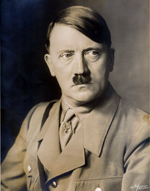 1.
Adolf Hitler 1889-1945)-His bloody career changed the world more
than any other, even more in it's unintended aftermath than in
it's immediate effects. Perhaps the most effective orator in history,
so central was his personal involvement to creating a European
German empire that it was in the end his very flaws which defeated
him as much as his foes. During the brief period when he was master
of Europe, his infliction of horrific cruelties and massacres
on millions of helpless victims surpassed the depravities of the
worst of the Roman emperors. The entire western world rose up
to defeat him, but it was the attempted conquest of Russia which
determined the outcome. His dark shadow persisted for many years
during the realignment of the world power balance which divided
Europe at the territory Russia in the East and the western allies
occupied at the end of the Second world War. Because of Hitler
we now have atomic weapons, powerful rockets, The United Nations
and bloated militaries.
1.
Adolf Hitler 1889-1945)-His bloody career changed the world more
than any other, even more in it's unintended aftermath than in
it's immediate effects. Perhaps the most effective orator in history,
so central was his personal involvement to creating a European
German empire that it was in the end his very flaws which defeated
him as much as his foes. During the brief period when he was master
of Europe, his infliction of horrific cruelties and massacres
on millions of helpless victims surpassed the depravities of the
worst of the Roman emperors. The entire western world rose up
to defeat him, but it was the attempted conquest of Russia which
determined the outcome. His dark shadow persisted for many years
during the realignment of the world power balance which divided
Europe at the territory Russia in the East and the western allies
occupied at the end of the Second world War. Because of Hitler
we now have atomic weapons, powerful rockets, The United Nations
and bloated militaries.
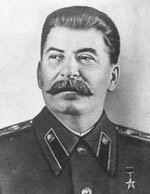 2.
Joseph Stalin (Joseph Visssarionovich Djugashvili) (1879-1953)-He
brutally whipped Russia into the industrial age, at a terrible
price. He displayed the cruel art of survival of the strongest
in his ruthless rise to power in the wake of the death of Vladimir
Lenin. He exported grain while millions of his countrymen were
starving just to 'keep up appearances'. Millions more of his subjects
were engulfed in the Gulag system, most never to return. When
Hitler invaded the Soviet Union many Russians initially welcomed
the Germans as liberators, only to be savaged and killed by soldiers
and especially by the SS. With most of the qualified generals
of his armed forces long dead from episodes of purges, immense
losses mounted as Stalin sought out the greatest surviving generals,
notably Georgy Zhukov. Stalin directed the entire economy of his
immense country toward pouring machines and men in an avalanche
of iron against the Germans, unflinchingly sustaining losses of
several men to each German killed. Stalin steadily defeated Hitler
in an industrial scale struggle to the death as titanic as the
rest of the Second World War put together. His ruthlessness was
shown not only to his foes in battle, but even to his own soldiers
who had become prisoners of war, including his own son. Later
he established a series of 'buffer states' between the USSR and
Western Europe, run by puppet governments. Stalin frightened the
west into continued technological competition which changed world
geopolitics.
2.
Joseph Stalin (Joseph Visssarionovich Djugashvili) (1879-1953)-He
brutally whipped Russia into the industrial age, at a terrible
price. He displayed the cruel art of survival of the strongest
in his ruthless rise to power in the wake of the death of Vladimir
Lenin. He exported grain while millions of his countrymen were
starving just to 'keep up appearances'. Millions more of his subjects
were engulfed in the Gulag system, most never to return. When
Hitler invaded the Soviet Union many Russians initially welcomed
the Germans as liberators, only to be savaged and killed by soldiers
and especially by the SS. With most of the qualified generals
of his armed forces long dead from episodes of purges, immense
losses mounted as Stalin sought out the greatest surviving generals,
notably Georgy Zhukov. Stalin directed the entire economy of his
immense country toward pouring machines and men in an avalanche
of iron against the Germans, unflinchingly sustaining losses of
several men to each German killed. Stalin steadily defeated Hitler
in an industrial scale struggle to the death as titanic as the
rest of the Second World War put together. His ruthlessness was
shown not only to his foes in battle, but even to his own soldiers
who had become prisoners of war, including his own son. Later
he established a series of 'buffer states' between the USSR and
Western Europe, run by puppet governments. Stalin frightened the
west into continued technological competition which changed world
geopolitics.
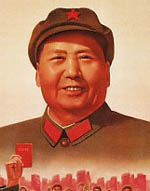 3.
Mao Tse Tung (1893-1976)- He took over a China pummeled by colonialism
and war and brought it to the frontier of world power status.
Sheltered from world accountability by secrecy and isolation,
he led the life of a living god in public, in private that of
a Roman Emperor. Mao's wife, Jaing Ching, inundated a generation
of Chinese youth with her series of tedious Model Operas. In 1957
Mao encouraged open criticism of the Chinese Communist Party,
then treated those who spoke up as public examples for his subsequent
Anti-rightist campaign. He 'flew into the ground' the economic
and especially agricultural infrastructure of China, causing famines
which killed tens of millions. His success in ruthlessly changing
his nation exceeded that of Stalin. Uncountable millions of people
grew up under carefully watched repressive conditions that made
the Soviet Union look like a paradise in comparison. The 'Cultural
Revolution' of the late 1960's brought further chaos and mass
arrests by youthful agitators against the established bureaucracy
and numerous contrived 'suspects'. At one time his diminutive
red bound volume of 'quotations' rivaled in the number of circulated
copies that of the Bible. As his permanent portrait overlooks
Tiananmen Square, his ideological ghost still haunts an awakening
China. To this day rebel movements in jungle nations kill in his
name.
3.
Mao Tse Tung (1893-1976)- He took over a China pummeled by colonialism
and war and brought it to the frontier of world power status.
Sheltered from world accountability by secrecy and isolation,
he led the life of a living god in public, in private that of
a Roman Emperor. Mao's wife, Jaing Ching, inundated a generation
of Chinese youth with her series of tedious Model Operas. In 1957
Mao encouraged open criticism of the Chinese Communist Party,
then treated those who spoke up as public examples for his subsequent
Anti-rightist campaign. He 'flew into the ground' the economic
and especially agricultural infrastructure of China, causing famines
which killed tens of millions. His success in ruthlessly changing
his nation exceeded that of Stalin. Uncountable millions of people
grew up under carefully watched repressive conditions that made
the Soviet Union look like a paradise in comparison. The 'Cultural
Revolution' of the late 1960's brought further chaos and mass
arrests by youthful agitators against the established bureaucracy
and numerous contrived 'suspects'. At one time his diminutive
red bound volume of 'quotations' rivaled in the number of circulated
copies that of the Bible. As his permanent portrait overlooks
Tiananmen Square, his ideological ghost still haunts an awakening
China. To this day rebel movements in jungle nations kill in his
name.
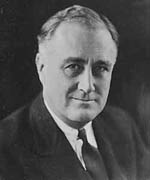 4.
Franklin Delano Roosevelt (1882-1945)- brought the United States
from the brink of decline to world power status during his extended
rule. His later leadership was directed towards helping to defeat
the aggressive empires of Germany and Japan. FDR was the first
of a few presidents often called by his initials in print. He
was the first and last President to break precedent and win election
four times, with a constitutional amendment soon written up and
passed to prevent this in the future. His initiating the 'Manhattan
Project' brought the Atomic Bomb to the U.S. well before the other
major powers.
4.
Franklin Delano Roosevelt (1882-1945)- brought the United States
from the brink of decline to world power status during his extended
rule. His later leadership was directed towards helping to defeat
the aggressive empires of Germany and Japan. FDR was the first
of a few presidents often called by his initials in print. He
was the first and last President to break precedent and win election
four times, with a constitutional amendment soon written up and
passed to prevent this in the future. His initiating the 'Manhattan
Project' brought the Atomic Bomb to the U.S. well before the other
major powers.
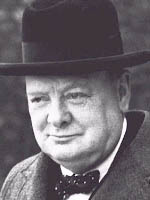 5.
Winston Churchill (1874-1965)- Rallied England in the critical
years of its deadly struggle with Hitler, during which Germany
was finally defeated. England's vast empire was shattered but
the country survived.
5.
Winston Churchill (1874-1965)- Rallied England in the critical
years of its deadly struggle with Hitler, during which Germany
was finally defeated. England's vast empire was shattered but
the country survived.
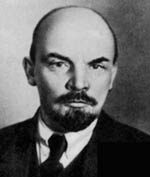 6.
Vladimir Lenin (1870-1924)-His 1917 Russian revolution created
an ideological bloc which eventually enslaved and murdered millions,
and stimulated the west to compete for worldwide influence and
military technology under the brutal rule of his successor.
6.
Vladimir Lenin (1870-1924)-His 1917 Russian revolution created
an ideological bloc which eventually enslaved and murdered millions,
and stimulated the west to compete for worldwide influence and
military technology under the brutal rule of his successor.
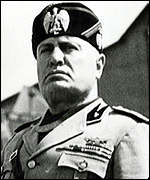 7.
Benito Mussolini (1883-1945)-Fascist ideology ran it's course
during the 20th, century, at least in it's more overt forms. Mussolini
started it all, his Fascist party first consolidating power at
home then acting as an ally to a later Fascist leader, this one
German, who was largely inspired by Mussolini's example. Later
he was swept up in Hitler's losing cause and was ultimately shot
while fleeing during the chaos of defeat.
7.
Benito Mussolini (1883-1945)-Fascist ideology ran it's course
during the 20th, century, at least in it's more overt forms. Mussolini
started it all, his Fascist party first consolidating power at
home then acting as an ally to a later Fascist leader, this one
German, who was largely inspired by Mussolini's example. Later
he was swept up in Hitler's losing cause and was ultimately shot
while fleeing during the chaos of defeat.
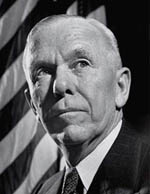 8.
George C. Marshall (1880-1959)-Although his role as a general
was considerable, his post war aid plan for western Europe used
America's vigorous post-war economy to nurture western Europe
through it's recovery. His 'Marshall Plan', announced in a Harvard
University speech in 1947, allowed an accelerated return by western
Europe to pre war living standards, and earned Marshall the Nobel
Peace Prize in 1953, the only professional soldier ever so awarded.
In addition to his efforts to promote peace and well being in
war ravaged regions, Marshall was also instrumental in forming
the North Atlantic treaty Alliance(NATO) which provided a standing
opposition to the massive Soviet military buildup in the Soviet
occupied regions gathered under the 'Warsaw Pact', the 'mirror
image' of NATO.
8.
George C. Marshall (1880-1959)-Although his role as a general
was considerable, his post war aid plan for western Europe used
America's vigorous post-war economy to nurture western Europe
through it's recovery. His 'Marshall Plan', announced in a Harvard
University speech in 1947, allowed an accelerated return by western
Europe to pre war living standards, and earned Marshall the Nobel
Peace Prize in 1953, the only professional soldier ever so awarded.
In addition to his efforts to promote peace and well being in
war ravaged regions, Marshall was also instrumental in forming
the North Atlantic treaty Alliance(NATO) which provided a standing
opposition to the massive Soviet military buildup in the Soviet
occupied regions gathered under the 'Warsaw Pact', the 'mirror
image' of NATO.
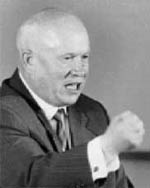 9.
Nikita Khrushchev (1894-1971)- Attaining leadership of the U.S.S.R.
after the 1953 death of Stalin, Khrushchev proceeded to dismantle
the gulag empire of his predecessor and exposed Stalin's horrors.
He marshaled the resources of his country in military and space
projects, the latter of which led to a series of spectacular space
'firsts'. Although more reasonable than Stalin, his occasional
bouts of belligerence and confrontation contributed to the peak
of the 'Cold War' tensions. This culminated in the 1962 'Cuban
Missile Crisis', the closest the world ever came to an atomic
war.
9.
Nikita Khrushchev (1894-1971)- Attaining leadership of the U.S.S.R.
after the 1953 death of Stalin, Khrushchev proceeded to dismantle
the gulag empire of his predecessor and exposed Stalin's horrors.
He marshaled the resources of his country in military and space
projects, the latter of which led to a series of spectacular space
'firsts'. Although more reasonable than Stalin, his occasional
bouts of belligerence and confrontation contributed to the peak
of the 'Cold War' tensions. This culminated in the 1962 'Cuban
Missile Crisis', the closest the world ever came to an atomic
war.
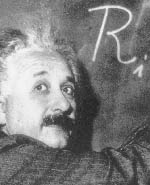 10.
Albert Einstein (1879-1955)- His mind made the greatest conceptual
leaps since Newton in understanding a greater range of the subtlties
of physical reality. The fateful letter to president Roosevelt
by physicist Leo Szilard which Einstein co-signed was pivotal
in starting the development of atomic weapons.
10.
Albert Einstein (1879-1955)- His mind made the greatest conceptual
leaps since Newton in understanding a greater range of the subtlties
of physical reality. The fateful letter to president Roosevelt
by physicist Leo Szilard which Einstein co-signed was pivotal
in starting the development of atomic weapons.
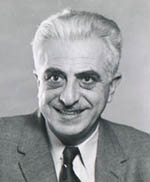 11.
Gregory Pincus (1903-1967)- Primary inventor of the birth control
pill in 1955, which consciously separated sex from procreation
and assisted in increasing the social options open to people.
He was influenced to invent 'The Pill' by woman's rights activist
Margaret Sanger beginning in 1951.
11.
Gregory Pincus (1903-1967)- Primary inventor of the birth control
pill in 1955, which consciously separated sex from procreation
and assisted in increasing the social options open to people.
He was influenced to invent 'The Pill' by woman's rights activist
Margaret Sanger beginning in 1951.
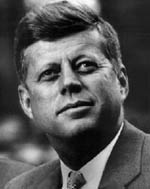 12.
John F. Kennedy (1917-1963)-Invigorated and socially enriched
an America rising to the peak of it's post war affluence. In Oct.
1962 JFK saw us through the Cuban missile crisis, our closest
brush with nuclear war. Kennedy was instrumental in implementing
the nuclear atmospheric test ban treaty. He also initiated project
Apollo, which established our ability to reach other worlds. His
assassination brought a sense of futility and disillusionment
which contributed to the reappraisal of values of the rising youth
movement.
12.
John F. Kennedy (1917-1963)-Invigorated and socially enriched
an America rising to the peak of it's post war affluence. In Oct.
1962 JFK saw us through the Cuban missile crisis, our closest
brush with nuclear war. Kennedy was instrumental in implementing
the nuclear atmospheric test ban treaty. He also initiated project
Apollo, which established our ability to reach other worlds. His
assassination brought a sense of futility and disillusionment
which contributed to the reappraisal of values of the rising youth
movement.
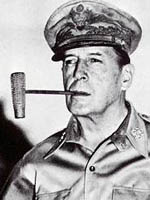
13. Douglas MacArthur (1880-1964)- Great
general not only instrumental in bringing the Japanese empire
to it's knees, but in presiding over the reworking of it's government.
He helped set the stage for the steady renewal of Japan's world
prominence in the post war era. The conflict between political
and military conduct of U.S. warfare policy led to his dismissal
during the Korean war by President Truman.
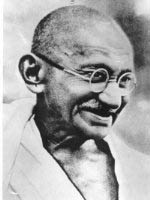 14.
Mahatma Gandhi (1869-1948)- Although many would place him higher
on this list for his non-violence ideals and what they could mean
for humanity if universally adopted, this wishful thinking is
not my rationale. Gandhi was probably more than anyone else the
one who galvanized India's independence movement in the wake of
weakening post war British influence in the region which changed
history and the destiny of many millions of people in what has
become the worlds largest democracy.
14.
Mahatma Gandhi (1869-1948)- Although many would place him higher
on this list for his non-violence ideals and what they could mean
for humanity if universally adopted, this wishful thinking is
not my rationale. Gandhi was probably more than anyone else the
one who galvanized India's independence movement in the wake of
weakening post war British influence in the region which changed
history and the destiny of many millions of people in what has
become the worlds largest democracy.
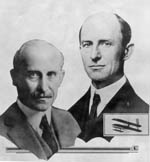 15.
Orville (1871-1948) and Wilbur (1867-1912) Wright- They knew powered
flight could be done, analyzed the unsuccessful efforts of others,
and built the first controllable heavier than air vehicle. Air
travel has since changed the degree of world commerce and brought
distant places within the experience of more people than ever.
Such machines have also rained death upon cities full of people
and have brought the destructive power equivalent to great natural
calamities within our grasp. I have decided to share the credit
between the brothers as Michael Hart has done in his book.
15.
Orville (1871-1948) and Wilbur (1867-1912) Wright- They knew powered
flight could be done, analyzed the unsuccessful efforts of others,
and built the first controllable heavier than air vehicle. Air
travel has since changed the degree of world commerce and brought
distant places within the experience of more people than ever.
Such machines have also rained death upon cities full of people
and have brought the destructive power equivalent to great natural
calamities within our grasp. I have decided to share the credit
between the brothers as Michael Hart has done in his book.
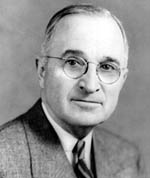 16.
Harry S. Truman (1884-1972) Soon after becoming President after
the death of FDR, Truman's decision to use the atomic bomb on
Japan to avoid a costly invasion gave the world a terrifying vision
of what atomic warfare would mean to humanity. Although Truman
refused to let Stalin intimidate him, his decision to fire general
MacArthur over differences in how the Korean war should be conducted
initiated the practice of overt 'limited warfare'. This marked
the beginning of U.S. 'wars without declaration' which avoid U.S.
congressional approval requirements to wage war, a precedent which
would reap bitter fruit in the future.
16.
Harry S. Truman (1884-1972) Soon after becoming President after
the death of FDR, Truman's decision to use the atomic bomb on
Japan to avoid a costly invasion gave the world a terrifying vision
of what atomic warfare would mean to humanity. Although Truman
refused to let Stalin intimidate him, his decision to fire general
MacArthur over differences in how the Korean war should be conducted
initiated the practice of overt 'limited warfare'. This marked
the beginning of U.S. 'wars without declaration' which avoid U.S.
congressional approval requirements to wage war, a precedent which
would reap bitter fruit in the future.
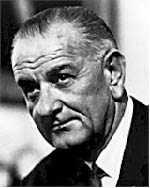 17.
Lyndon Baines Johnson (1908-1973)-taking office after the Assassination
of JFK, he oversaw the completion of the ambitious civil rights
and space initiatives of his predecessor. LBJ would deserve prominent
recognition for these achievements alone, but his greatest legacy
ended up being one of America's great tragedies. The U.S. military
aid to south Vietnam always seemed to need just another increase
in troop commitments to bring us to 'the light at the end of the
tunnel'. A war of deliberately limited scope was conducted against
the northern communist forces, perhaps from fear of provoking
the USSR and China, perhaps because a real victory would be simply
impractical. Casualties mounted with little to show for them as
the north Vietnamese forces worked around our strategy. In the
end, the corruption of southern Vietnamese officials (but not
the soldiers) and the determination of the northern forces were
the decisive factors. Although hardly a battle was lost America
ended up with it's first humiliating defeat. Later in the undeclared
war many young people were galvanized to question the war, authority
and societal assumptions in general. Many lives and direction
of America's resources in a critical time were altered radically
by decisions LBJ made.
17.
Lyndon Baines Johnson (1908-1973)-taking office after the Assassination
of JFK, he oversaw the completion of the ambitious civil rights
and space initiatives of his predecessor. LBJ would deserve prominent
recognition for these achievements alone, but his greatest legacy
ended up being one of America's great tragedies. The U.S. military
aid to south Vietnam always seemed to need just another increase
in troop commitments to bring us to 'the light at the end of the
tunnel'. A war of deliberately limited scope was conducted against
the northern communist forces, perhaps from fear of provoking
the USSR and China, perhaps because a real victory would be simply
impractical. Casualties mounted with little to show for them as
the north Vietnamese forces worked around our strategy. In the
end, the corruption of southern Vietnamese officials (but not
the soldiers) and the determination of the northern forces were
the decisive factors. Although hardly a battle was lost America
ended up with it's first humiliating defeat. Later in the undeclared
war many young people were galvanized to question the war, authority
and societal assumptions in general. Many lives and direction
of America's resources in a critical time were altered radically
by decisions LBJ made.
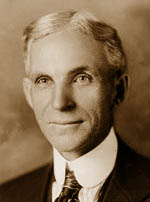 18.
Henry Ford (1863-1947)-His innovations in manufacturing and mass
production made possible the 1908 introduction of the 'Model T',
a car deliberately designed not only for simplicity and durability,
but for widespread availability at an affordable price. His visionary
approach to business widely affected the lives of millions of
people as he not only built cars, but promoted the building of
paved road networks and gas stations. Henry Ford was both enlightened
and despotic in running his business. High wages were paid to
his workers, promoting the establishment of a 'middle class' whose
income allowed discretionary spending on items besides those needed
for survival. He used his private police force to fight unionization
efforts in his company, paid company counselors to inform on troubled
employees which he would then fire. He dabbled in such diverse
pursuits as anti-Semitic ravings in his newspaper, the 'Dearborn
Independent', and hiring an ocean liner filled with prominent
pacifists in November 1915 to conduct a 'mass meditation' near
Europe in hopes of ending the First World War! Before Henry Ford
only 20 percent of Americans lived in cities. Thanks to the new
mobility provided by reliable personal transportation, by World
War II half the people lived in cities. The assembly line process
which Ford pioneered not only allowed a Model T to be turned out
every 24 seconds, such mass production techniques applied to weapons
manufacture during the First then the Second World Wars caused
the arming of Humanity on a scale and uniformity unimaginable
to earlier ages.
18.
Henry Ford (1863-1947)-His innovations in manufacturing and mass
production made possible the 1908 introduction of the 'Model T',
a car deliberately designed not only for simplicity and durability,
but for widespread availability at an affordable price. His visionary
approach to business widely affected the lives of millions of
people as he not only built cars, but promoted the building of
paved road networks and gas stations. Henry Ford was both enlightened
and despotic in running his business. High wages were paid to
his workers, promoting the establishment of a 'middle class' whose
income allowed discretionary spending on items besides those needed
for survival. He used his private police force to fight unionization
efforts in his company, paid company counselors to inform on troubled
employees which he would then fire. He dabbled in such diverse
pursuits as anti-Semitic ravings in his newspaper, the 'Dearborn
Independent', and hiring an ocean liner filled with prominent
pacifists in November 1915 to conduct a 'mass meditation' near
Europe in hopes of ending the First World War! Before Henry Ford
only 20 percent of Americans lived in cities. Thanks to the new
mobility provided by reliable personal transportation, by World
War II half the people lived in cities. The assembly line process
which Ford pioneered not only allowed a Model T to be turned out
every 24 seconds, such mass production techniques applied to weapons
manufacture during the First then the Second World Wars caused
the arming of Humanity on a scale and uniformity unimaginable
to earlier ages.
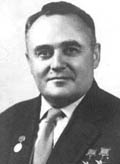 19.
Sergei Korolev (1907-1966)- The Ukrainian rocket genius who suffered
through the Gulag system during the depraved reign of Stalin.
After being 'rehabilitated', Korolev rose swiftly to the esteemed
(and anonymous) position of 'Chief Designer'. His energetic marshaling
of the skills of his country brought the Soviet Union to world
technological prominence with the fabrication of the first ballistic
missile capability, and especially the launch of Sputnik 1. He
later supervised the launching of the first man in space, Yuri
Gagarin. These achievements prompted a massive U.S. effort to
surpass Russia's space capability, culminating in the Apollo program.
His death in a botched operation in early 1966 cost the Soviet
Union its chances of winning the Moon race.
19.
Sergei Korolev (1907-1966)- The Ukrainian rocket genius who suffered
through the Gulag system during the depraved reign of Stalin.
After being 'rehabilitated', Korolev rose swiftly to the esteemed
(and anonymous) position of 'Chief Designer'. His energetic marshaling
of the skills of his country brought the Soviet Union to world
technological prominence with the fabrication of the first ballistic
missile capability, and especially the launch of Sputnik 1. He
later supervised the launching of the first man in space, Yuri
Gagarin. These achievements prompted a massive U.S. effort to
surpass Russia's space capability, culminating in the Apollo program.
His death in a botched operation in early 1966 cost the Soviet
Union its chances of winning the Moon race.
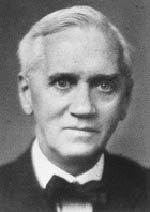 20.
Alexander Fleming (1881-1955)- Taking up the study of medicine
at age 20, this Scotsman concentrated on bacteriology. During
World War I as captain in the Army medical Corps he worked to
reduce the deaths of wounded soldiers from infected wounds. While
searching for anti bacterial treatments which were not also dangerous
to the patient. In 1928 Fleming was discarding old petri dish
cultures when he noticed a distinctive mold eating into a virus
culture, which surprisingly killed off the staphylococcus anywhere
near it. Fleming isolated this mold and soon discovered a strain
of the Penicillia which attacked only invading bacteria and not
the surrounding living tissue, effective when diluted as much
as 800 times. Work on Penicillin lagged for years until the storm
clouds of War again loomed on the horizon, stimulating research
in medical as well as military progress. By the Second World War
British and American companies mass produced Penicillin, saving
the lives of uncountable thousands of soldiers and millions of
civilians in decades to come. The introduction of the medical
use of Penicillin in 1928 by Alexander Fleming marked a giant
step in humanity's struggle with disease.
20.
Alexander Fleming (1881-1955)- Taking up the study of medicine
at age 20, this Scotsman concentrated on bacteriology. During
World War I as captain in the Army medical Corps he worked to
reduce the deaths of wounded soldiers from infected wounds. While
searching for anti bacterial treatments which were not also dangerous
to the patient. In 1928 Fleming was discarding old petri dish
cultures when he noticed a distinctive mold eating into a virus
culture, which surprisingly killed off the staphylococcus anywhere
near it. Fleming isolated this mold and soon discovered a strain
of the Penicillia which attacked only invading bacteria and not
the surrounding living tissue, effective when diluted as much
as 800 times. Work on Penicillin lagged for years until the storm
clouds of War again loomed on the horizon, stimulating research
in medical as well as military progress. By the Second World War
British and American companies mass produced Penicillin, saving
the lives of uncountable thousands of soldiers and millions of
civilians in decades to come. The introduction of the medical
use of Penicillin in 1928 by Alexander Fleming marked a giant
step in humanity's struggle with disease.
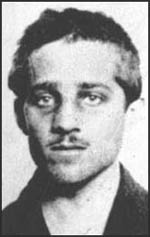 21.
Gavrilo Princip (1894- 1918)-This 19 year old Serbian gangster
did not set out to change the course of world history, all he
intended to do was assassinate the Archduke Franz Ferdinand, leader
of Austria-Hungary while pursuing the nationalist aims of the
'Black Hand' mobsters. The Archduke and his wife were shot by
Princip during their visit to Sarajevo after his henchmen failed
to do the job earlier that fateful June 28, 1914 day. Austria-Hungary
then declared war on Serbia, and the many alliances lined up to
support their commitments with the first world war the result.
8.5 million deaths in the battlefield followed as soldiers fell
victim to machine guns, artillery barrages, poison gas, disease,
and wasteful tactics. The technology of mass killing had come
of age. Among the momentous side effects of the 'War To End All
Wars' were the erasing of old kingdoms and regimes including the
Turkish Ottoman Empire, the Bolshevik Revolution in Russia, the
decimation of a generation of Frenchmen, and the rise of Fascism
in Italy and Germany. The Germans were to rise again, partly fueled
by resentment over crushing war reparations imposed after their
defeat in 1918. The tanks, submarines, and aircraft used in the
second world war were refinements of those introduced in the First.
21.
Gavrilo Princip (1894- 1918)-This 19 year old Serbian gangster
did not set out to change the course of world history, all he
intended to do was assassinate the Archduke Franz Ferdinand, leader
of Austria-Hungary while pursuing the nationalist aims of the
'Black Hand' mobsters. The Archduke and his wife were shot by
Princip during their visit to Sarajevo after his henchmen failed
to do the job earlier that fateful June 28, 1914 day. Austria-Hungary
then declared war on Serbia, and the many alliances lined up to
support their commitments with the first world war the result.
8.5 million deaths in the battlefield followed as soldiers fell
victim to machine guns, artillery barrages, poison gas, disease,
and wasteful tactics. The technology of mass killing had come
of age. Among the momentous side effects of the 'War To End All
Wars' were the erasing of old kingdoms and regimes including the
Turkish Ottoman Empire, the Bolshevik Revolution in Russia, the
decimation of a generation of Frenchmen, and the rise of Fascism
in Italy and Germany. The Germans were to rise again, partly fueled
by resentment over crushing war reparations imposed after their
defeat in 1918. The tanks, submarines, and aircraft used in the
second world war were refinements of those introduced in the First.
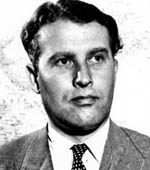 22.
Werner Von Braun (1912-1977)- This resourceful rocket pioneer
was not only a gifted engineer but an excellent organizer of talent.
When approached by German army ordinance expert Walter Dornberger
to build rockets for the military, Von Braun realized the possibilities
opening up well beyond what his rocket club could accomplish with
it's meager resources. While weathering the various funding and
priority crises, Von Braun's team steadily elevated the rocket
from a firework to a large vehicle. In 1943 the A-4 rocket, later
known as the V-2, became the first machine to touch the edge of
space. Although this weapon appeared too late to alter the fate
of Germany in the second world war, the implications of this technology
were realized by the victorious superpowers. Von Braun's team
deliberately surrendered to America, where they sensed they had
the best chance of continuing their rocket development. When John
F. Kennedy decided to send Americans to the Moon, Von Braun and
his talented team were among the core group which developed the
massive Saturn rockets which made the voyages possible. In two
episodes of opportunity and development a continent and generation
apart essentially the same team was able to seize the opportunity
to realize the dream of making it possible to visit another world.
22.
Werner Von Braun (1912-1977)- This resourceful rocket pioneer
was not only a gifted engineer but an excellent organizer of talent.
When approached by German army ordinance expert Walter Dornberger
to build rockets for the military, Von Braun realized the possibilities
opening up well beyond what his rocket club could accomplish with
it's meager resources. While weathering the various funding and
priority crises, Von Braun's team steadily elevated the rocket
from a firework to a large vehicle. In 1943 the A-4 rocket, later
known as the V-2, became the first machine to touch the edge of
space. Although this weapon appeared too late to alter the fate
of Germany in the second world war, the implications of this technology
were realized by the victorious superpowers. Von Braun's team
deliberately surrendered to America, where they sensed they had
the best chance of continuing their rocket development. When John
F. Kennedy decided to send Americans to the Moon, Von Braun and
his talented team were among the core group which developed the
massive Saturn rockets which made the voyages possible. In two
episodes of opportunity and development a continent and generation
apart essentially the same team was able to seize the opportunity
to realize the dream of making it possible to visit another world.
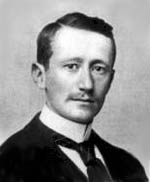 23.
Guglielmo Marconi (1874-1937)-From ancient times until 1844, when
the the telegraph invented by by Samuel Morse first transmitted
news, the fastest that detailed information could travel was achieved
with carefully managed horsemen carrying pouches of documents
to fresh teams of horses and riders. The news of the death of
Nero was able to be carried in this fashion a then amazing 200
miles a day from Rome to Spain. The apex of this art was reached
by the American 'Pony Express' which routinely matched that speed,
indeed once achieving a record of 255 miles a day. After running
(at a deficit) for 18 months the completion of the telegraph line
along that route on October 24, 1871 was a landmark in the history
of distribution of information. Technology for allowing mass communication
was becoming practical early in the 20th century, springing from
the pioneering work of people like Nikola Tesla, Thomas Alva Edison,
Jagdish Chandra Bose and and many others. As early as 1896 Alexander
Popov demonstrated the transmission of radio waves across the
campus of the St. Petersburg Physical Society. Practical breakthroughs
in radio broadcasting were accomplished in 1896 by Marconi starting
with relatively short range transmissions of a few kilometers,
culminating in the first trans-Atlantic radio signals by early
1902, with regular news broadcasts crossing the Atlantic next
year. A highlight of 1903 was the sending of the first radio message
between U.S. President Theodore Roosevelt and Edward VII Wettin,
King of England by Marconi using his radio station near Wellfleet,
MA. World War I caused the shutting down of developments in entertainment
based radio, but afterwards Marconi pioneered the use of wireless
commercial broadcasting in 1922. Within several years radio would
be familiar to millions, with voice broadcasts of immediate importance
traveling further and faster than printed media. Marconi cast
the first strands of the web of mass communication which was to
lead to millions of people being aware of events instantaneously.
The speed the spoken word could travel had become that of light
itself.
23.
Guglielmo Marconi (1874-1937)-From ancient times until 1844, when
the the telegraph invented by by Samuel Morse first transmitted
news, the fastest that detailed information could travel was achieved
with carefully managed horsemen carrying pouches of documents
to fresh teams of horses and riders. The news of the death of
Nero was able to be carried in this fashion a then amazing 200
miles a day from Rome to Spain. The apex of this art was reached
by the American 'Pony Express' which routinely matched that speed,
indeed once achieving a record of 255 miles a day. After running
(at a deficit) for 18 months the completion of the telegraph line
along that route on October 24, 1871 was a landmark in the history
of distribution of information. Technology for allowing mass communication
was becoming practical early in the 20th century, springing from
the pioneering work of people like Nikola Tesla, Thomas Alva Edison,
Jagdish Chandra Bose and and many others. As early as 1896 Alexander
Popov demonstrated the transmission of radio waves across the
campus of the St. Petersburg Physical Society. Practical breakthroughs
in radio broadcasting were accomplished in 1896 by Marconi starting
with relatively short range transmissions of a few kilometers,
culminating in the first trans-Atlantic radio signals by early
1902, with regular news broadcasts crossing the Atlantic next
year. A highlight of 1903 was the sending of the first radio message
between U.S. President Theodore Roosevelt and Edward VII Wettin,
King of England by Marconi using his radio station near Wellfleet,
MA. World War I caused the shutting down of developments in entertainment
based radio, but afterwards Marconi pioneered the use of wireless
commercial broadcasting in 1922. Within several years radio would
be familiar to millions, with voice broadcasts of immediate importance
traveling further and faster than printed media. Marconi cast
the first strands of the web of mass communication which was to
lead to millions of people being aware of events instantaneously.
The speed the spoken word could travel had become that of light
itself.
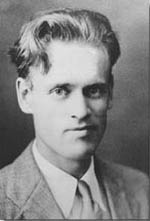 24.
Philo Taylor Farnsworth (1906-1971)- As with radio, numerous people
conceived and tinkered with the idea of transmitting live images
over the airwaves. As early as 1885 the first patents for transmitting
images were filed by a young German genius named Paul Gottlieb
Nipkow, who conceived of using a spinning perforated disk to scan
and display images. The 1897 invention of the Cathode Ray Tube
by German physicist Karl Ferdinand Braun laid the foundation for
visual displays for x-ray machines, radar detectors, and finally
television. The word 'Television' was first used by the Russian
lecturer Constantin Perskyi at the Paris International Worlds
Fair on August 25, 1900. Other Russians were prominent in developments
of early television using electronic means, whose compact size
and inherent versatility would assure its eventual triumph over
the ungainly 'mechanical' disk scanning system, as developed by
John Baird and Charles Jenkins from the late 1920's to early 1930's.
The earliest 'aired' image using a mechanical scan disk TV system
was a 1929 broadcast of a small statue of cartoon character 'Felix
the Cat' which was glued to a rotating record turntable. Philo
T. Farnsworth, a genius emerging from a Mormon family in rural
Idaho, first drew up designs for electronic television technology
in 1920 at age 14! Farnsworth had a working prototype in his San
Francisco laboratory by Autumn 1927. Farnsworth was the first
person to form and manipulate an electron beam. On September 27
1927 the first electronic television picture was shown of an opaque
line painted on a glass slide placed before the hand built camera.
Rotating the slide resulted in the line instantaneously rotating
in kind on a small phosphorescent screen, improvised from a flat
bottomed conical Erlenmeyer flask, in an adjoining darkened room.
The first moving subject is said to be of a wisp of cigarette
smoke drifting within the field of view. Vladimir Zworykin, Russian
television pioneer, also made important conceptual and practical
leaps in his own work to bring about television, but his efforts
did not produce functioning hardware until 1933. RCA President
David Sarnoff's efforts to buy Farnsworths patents were rebuffed,
and Sarnoff applied the pressure of his RCA corporation against
Farnsworth's efforts to work with the competing Philco company.
A protracted legal battle between Sarnoff and Farnsworth over
the ownership of the patent for electronic television eventually
led to a victory for Philo, but but at a terrible personal cost
to the inventor of electronic television. A mysterious fire which
destroyed his lab and notes led to a long sad decline into depression
and drink. Television as we know it owes its existence to this
energetic and tragic figure. Interestingly, the only appearance
of Farnsworth on the medium he invented was as a guest in the
television game show 'What's My Line'. Late in his life Farnsworth
was greatly disappointed in how the medium he helped invent was
being used, with the constructive uses he had foreseen largely
unrealized. As Philo and his wife Pem watched the Apollo 11 moon
walk, some measure of the potential greatness of the medium must
have stirred within him. Although showing live events continues
as a prominent and occasionally informative use of TV, most uses
of the ability to provide mass shared experiences is squandered
on sporting events, carefully censored and selectively highlighted
news, and appeals to any human instinct which can be stimulated
to sell myriads of products. The sheer quantity of varied entertainment
produced in the commercial and ratings driven television industry
has helped to diminish the amount of reading, of critical thinking,
and indeed the amount of conversation among people.
24.
Philo Taylor Farnsworth (1906-1971)- As with radio, numerous people
conceived and tinkered with the idea of transmitting live images
over the airwaves. As early as 1885 the first patents for transmitting
images were filed by a young German genius named Paul Gottlieb
Nipkow, who conceived of using a spinning perforated disk to scan
and display images. The 1897 invention of the Cathode Ray Tube
by German physicist Karl Ferdinand Braun laid the foundation for
visual displays for x-ray machines, radar detectors, and finally
television. The word 'Television' was first used by the Russian
lecturer Constantin Perskyi at the Paris International Worlds
Fair on August 25, 1900. Other Russians were prominent in developments
of early television using electronic means, whose compact size
and inherent versatility would assure its eventual triumph over
the ungainly 'mechanical' disk scanning system, as developed by
John Baird and Charles Jenkins from the late 1920's to early 1930's.
The earliest 'aired' image using a mechanical scan disk TV system
was a 1929 broadcast of a small statue of cartoon character 'Felix
the Cat' which was glued to a rotating record turntable. Philo
T. Farnsworth, a genius emerging from a Mormon family in rural
Idaho, first drew up designs for electronic television technology
in 1920 at age 14! Farnsworth had a working prototype in his San
Francisco laboratory by Autumn 1927. Farnsworth was the first
person to form and manipulate an electron beam. On September 27
1927 the first electronic television picture was shown of an opaque
line painted on a glass slide placed before the hand built camera.
Rotating the slide resulted in the line instantaneously rotating
in kind on a small phosphorescent screen, improvised from a flat
bottomed conical Erlenmeyer flask, in an adjoining darkened room.
The first moving subject is said to be of a wisp of cigarette
smoke drifting within the field of view. Vladimir Zworykin, Russian
television pioneer, also made important conceptual and practical
leaps in his own work to bring about television, but his efforts
did not produce functioning hardware until 1933. RCA President
David Sarnoff's efforts to buy Farnsworths patents were rebuffed,
and Sarnoff applied the pressure of his RCA corporation against
Farnsworth's efforts to work with the competing Philco company.
A protracted legal battle between Sarnoff and Farnsworth over
the ownership of the patent for electronic television eventually
led to a victory for Philo, but but at a terrible personal cost
to the inventor of electronic television. A mysterious fire which
destroyed his lab and notes led to a long sad decline into depression
and drink. Television as we know it owes its existence to this
energetic and tragic figure. Interestingly, the only appearance
of Farnsworth on the medium he invented was as a guest in the
television game show 'What's My Line'. Late in his life Farnsworth
was greatly disappointed in how the medium he helped invent was
being used, with the constructive uses he had foreseen largely
unrealized. As Philo and his wife Pem watched the Apollo 11 moon
walk, some measure of the potential greatness of the medium must
have stirred within him. Although showing live events continues
as a prominent and occasionally informative use of TV, most uses
of the ability to provide mass shared experiences is squandered
on sporting events, carefully censored and selectively highlighted
news, and appeals to any human instinct which can be stimulated
to sell myriads of products. The sheer quantity of varied entertainment
produced in the commercial and ratings driven television industry
has helped to diminish the amount of reading, of critical thinking,
and indeed the amount of conversation among people.
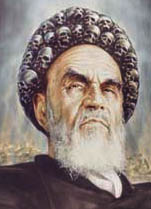 25.
Ayatollah Ruhollah Khomeini (1901?-1989) He championed a 'Shi'i
' Islamic creed whose medieval ideals and lifestyle as he preached
them contrasted startlingly with the overall trends toward progress
in Human affairs. Many Islamic fundamentalist believers, dismayed
by the Western influences 'polluting' their region, became fanatical
allies and followers of his cause. Traditional Persian potential
for provoked ferocity, which even the Roman legions feared, was
manifested in extremely intense Shi'i religious movements whose
fire could not be quenched by the despotic Shah of Iran, only
contained. Exiled from the Iranian 'holy city' of Qom after agitating
against land reform and women's emancipation initiatives by the
Shah, Khomeini went into exile in Turkey, Iraq, and finally France.
Khomeini assumed the high religious title 'Ayatollah' and distributed
mass copied audio cassettes disguised as music to be smuggled
into Iran promoting religion and revolution. Although the Shah,
backed by American intervention in Iranian politics, was sympathetic
to the virtues of modern life he ruled with an iron hand. Fierce
clashes with a rising Islamic Fundamentalist led revolution created
walls of dead bodies in the streets. Seizing the opportunity as
the Shah was dying of cancer in the U.S., Khomeini began an Islamic
revolution which swept the country in a wave of murderous terror.
Women were cast from schools, law books were replaced by Islamic
texts, and all Western influences were ruthlessly suppressed.
With Khomeini's support a frenzied mob attacked the U.S. Embassy
in Teheran, taking 55 hostages. President Carter allowed the situation
to drag on until an inadequate rescue mission was launched, small
enough for a collision between two aircraft during a blinding
dust storm to cause a general retreat. The burned bodies of U.S.
servicemen left behind were put on public display by the Iranian
government. During this time America was provoked into many demonstrations
of rage against Iran in graffiti, music and in print. A sense
of enraged anguish in much of America influenced the U.S. elections,
resulting in the election of actor turned conservative politician
Ronald Reagan. As a final insult to President Jimmy Carter (or
concern about the response of his successor) the hostages were
released after 444 days of captivity, the day the new U.S.President
was inaugurated. A war started in 1980 by Iraq had since became
a personal vendetta between Ayatollah Khomeini and Saddam Hussein.
Recalling the horrors of of World War I trench warfare complete
with poison gas, Iran and Iraq sent thousands of soldiers to die
in attacks mounted with no regard to casualties.Thousands of women
were worked into Islamic frenzy by Iranian clerics and sent to
clear mine fields by stepping on and detonating them. During the
war U.S. intelligence agencies provided Iraq with Iranian troop
locations from satellite photographs of the battlefield which
contributed to the deaths of uncountable thousands of Iranian
soldiers. After 8 years the Iran-Iraq war ended, after a million
deaths and innumerable wounded. Iran then focused on exporting
Islamic revolution, giving support to supportive movements and
persons across the Middle East. Networking was facilitated between
malcontents who would later be instrumental in Islamic terrorist
groups like Al Qaeda. He also issued 'Fatwa' death warrants for
thousands of people, most prominently author Salmon Rushdie for
writing a parody of Islam called 'The Satanic Verses'. The reign
of Ayatollah Khomeini marked the first time the West heard defiant
proclamations condemning 'Satan America' made by an Islamic government,
and in the wild eyed self flagellating crowds widely televised
during his reign we first beheld the face of fanatical Moslem
hatred of the West. Later revolutionary Islamic movements and
some terrorist organizations were emboldened by the precedent
set by Ayatollah Khomeini, particularly Osama Bin Laden. As the
West and Fundamentalist Islam confront each other, the spirit
of Ayatollah Khomeini stands tall among the heroes of the weapon
waving hoards.
25.
Ayatollah Ruhollah Khomeini (1901?-1989) He championed a 'Shi'i
' Islamic creed whose medieval ideals and lifestyle as he preached
them contrasted startlingly with the overall trends toward progress
in Human affairs. Many Islamic fundamentalist believers, dismayed
by the Western influences 'polluting' their region, became fanatical
allies and followers of his cause. Traditional Persian potential
for provoked ferocity, which even the Roman legions feared, was
manifested in extremely intense Shi'i religious movements whose
fire could not be quenched by the despotic Shah of Iran, only
contained. Exiled from the Iranian 'holy city' of Qom after agitating
against land reform and women's emancipation initiatives by the
Shah, Khomeini went into exile in Turkey, Iraq, and finally France.
Khomeini assumed the high religious title 'Ayatollah' and distributed
mass copied audio cassettes disguised as music to be smuggled
into Iran promoting religion and revolution. Although the Shah,
backed by American intervention in Iranian politics, was sympathetic
to the virtues of modern life he ruled with an iron hand. Fierce
clashes with a rising Islamic Fundamentalist led revolution created
walls of dead bodies in the streets. Seizing the opportunity as
the Shah was dying of cancer in the U.S., Khomeini began an Islamic
revolution which swept the country in a wave of murderous terror.
Women were cast from schools, law books were replaced by Islamic
texts, and all Western influences were ruthlessly suppressed.
With Khomeini's support a frenzied mob attacked the U.S. Embassy
in Teheran, taking 55 hostages. President Carter allowed the situation
to drag on until an inadequate rescue mission was launched, small
enough for a collision between two aircraft during a blinding
dust storm to cause a general retreat. The burned bodies of U.S.
servicemen left behind were put on public display by the Iranian
government. During this time America was provoked into many demonstrations
of rage against Iran in graffiti, music and in print. A sense
of enraged anguish in much of America influenced the U.S. elections,
resulting in the election of actor turned conservative politician
Ronald Reagan. As a final insult to President Jimmy Carter (or
concern about the response of his successor) the hostages were
released after 444 days of captivity, the day the new U.S.President
was inaugurated. A war started in 1980 by Iraq had since became
a personal vendetta between Ayatollah Khomeini and Saddam Hussein.
Recalling the horrors of of World War I trench warfare complete
with poison gas, Iran and Iraq sent thousands of soldiers to die
in attacks mounted with no regard to casualties.Thousands of women
were worked into Islamic frenzy by Iranian clerics and sent to
clear mine fields by stepping on and detonating them. During the
war U.S. intelligence agencies provided Iraq with Iranian troop
locations from satellite photographs of the battlefield which
contributed to the deaths of uncountable thousands of Iranian
soldiers. After 8 years the Iran-Iraq war ended, after a million
deaths and innumerable wounded. Iran then focused on exporting
Islamic revolution, giving support to supportive movements and
persons across the Middle East. Networking was facilitated between
malcontents who would later be instrumental in Islamic terrorist
groups like Al Qaeda. He also issued 'Fatwa' death warrants for
thousands of people, most prominently author Salmon Rushdie for
writing a parody of Islam called 'The Satanic Verses'. The reign
of Ayatollah Khomeini marked the first time the West heard defiant
proclamations condemning 'Satan America' made by an Islamic government,
and in the wild eyed self flagellating crowds widely televised
during his reign we first beheld the face of fanatical Moslem
hatred of the West. Later revolutionary Islamic movements and
some terrorist organizations were emboldened by the precedent
set by Ayatollah Khomeini, particularly Osama Bin Laden. As the
West and Fundamentalist Islam confront each other, the spirit
of Ayatollah Khomeini stands tall among the heroes of the weapon
waving hoards.
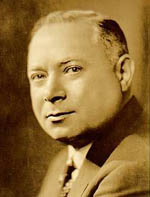 26.
David Sarnoff (1891-1971)- Figuratively standing on the shoulders
of (and occasionally stepping on) giants, this visionary businessman
sought and promoted the widespread use of first sound then visual
mass media. A Russian immigrant, Sarnoff learned English by reading
discarded newspapers, soon this upcoming 'media mogul' had his
own news stand. While working for the American Marconi Company
he was one of the wireless radio operators relaying reports of
the sinking of the Titanic. After the Marconi company was sold
to General Electric in 1919, Sarnoff moved to the newborn Radio
Corporation of America, which purchased New York radio station
WEAF in 1926 initiating the National Broadcast Company, NBC. Even
as he was consolidating his radio empire, becoming president of
RCA in 1930, he saw the potential for television broadcasting
and sought out experts in the infant field, most notably Russian
television pioneer Vladimir Zworykin. Vital patents belonging
to Philo T. Farnsworth were not for outright sale so Sarnoff spent
years and millions of dollars rather than pay royalties to Farnsworth.
Vladimir Zworykin did much to advance the early art of television
technology, particularly in camera design, and went on to create
other valuable inventions including an electron Microscope. His
lengthy visit to Farnsworths' laboratory in April 1930 eventually
led to suspicion that some of Zworykins' work for Sarnoff was
being directed toward duplicating some aspects of Farnsworths'
efforts. After protracted legal efforts to invalidate Farnsworths
patents failed, arrangements were finally made in 1939 to pay
him for his technology. The next battle for Sarnoff was over the
broadcast standards for television, which raged for over five
years. Sarnoff used his available 343 line television equipment
to send to a few New York receivers the April 20, 1939 opening
of the New York Worlds Fair. At the fair Franklin Roosevelt thus
became the first President to appear on a TV broadcast (Herbert
Hoover was seen in a 'closed circuit' scan disk TV transmission
on April 7, 1927). Finally on March 8, 1941, after struggles for
influence between RCA and other early movers in the infant television
business, the Federal Communications Commissions National Television
Standards Committee adopted a 525 line interlaced 30 frame per
second video standard, known ever since by the initials NTSC.
World War II caused an interruption of civilian television development
similar to that of radio during the first World War. As the decade
of the 1940's drew to a close television sets became a common
sight in homes. Sarnoff intervened in the initial approval by
the FCC of a high quality color television system developed by
CBS, which was incompatible with the millions of existing black
and white sets. This struggle between technical and commercial
forces became in effect a battle of wills between Sarnoff, president
of RCA-CBS and CBS Chairman William Paley. Various factors resulted
in the 1953 adoption of a compromised but readily available color
system which was compatible with existing NTSC standards, allowing
a monochrome version of its image to be seen on black and white
sets. The RCA influenced NTSC color video standard was adopted
December 23, 1953 and is used to this day. For years until its
evenmtual perfection the variable quality of NTSC television prompted
TV engineers to state that NTSC stood for 'Never The Same Color'!
It is considered likely that the efforts of Sarnoff advanced by
several years the introduction of color television. Yet another
legal battle, this one with old friend Edwin Howard Armstrong
over the patents for FM radio, raged for years until Armstrong
was driven to suicide in 1954. Upon the death of Sarnoff in 1970,
his major role in the commercial development and growth of modern
mass media was acknowledged in a lengthy obituary in the New York
Times, referring to David Sarnoff as 'A man of astounding vision
who was able to see with remarkable clarity the possibilities
of harnessing the electron'.
26.
David Sarnoff (1891-1971)- Figuratively standing on the shoulders
of (and occasionally stepping on) giants, this visionary businessman
sought and promoted the widespread use of first sound then visual
mass media. A Russian immigrant, Sarnoff learned English by reading
discarded newspapers, soon this upcoming 'media mogul' had his
own news stand. While working for the American Marconi Company
he was one of the wireless radio operators relaying reports of
the sinking of the Titanic. After the Marconi company was sold
to General Electric in 1919, Sarnoff moved to the newborn Radio
Corporation of America, which purchased New York radio station
WEAF in 1926 initiating the National Broadcast Company, NBC. Even
as he was consolidating his radio empire, becoming president of
RCA in 1930, he saw the potential for television broadcasting
and sought out experts in the infant field, most notably Russian
television pioneer Vladimir Zworykin. Vital patents belonging
to Philo T. Farnsworth were not for outright sale so Sarnoff spent
years and millions of dollars rather than pay royalties to Farnsworth.
Vladimir Zworykin did much to advance the early art of television
technology, particularly in camera design, and went on to create
other valuable inventions including an electron Microscope. His
lengthy visit to Farnsworths' laboratory in April 1930 eventually
led to suspicion that some of Zworykins' work for Sarnoff was
being directed toward duplicating some aspects of Farnsworths'
efforts. After protracted legal efforts to invalidate Farnsworths
patents failed, arrangements were finally made in 1939 to pay
him for his technology. The next battle for Sarnoff was over the
broadcast standards for television, which raged for over five
years. Sarnoff used his available 343 line television equipment
to send to a few New York receivers the April 20, 1939 opening
of the New York Worlds Fair. At the fair Franklin Roosevelt thus
became the first President to appear on a TV broadcast (Herbert
Hoover was seen in a 'closed circuit' scan disk TV transmission
on April 7, 1927). Finally on March 8, 1941, after struggles for
influence between RCA and other early movers in the infant television
business, the Federal Communications Commissions National Television
Standards Committee adopted a 525 line interlaced 30 frame per
second video standard, known ever since by the initials NTSC.
World War II caused an interruption of civilian television development
similar to that of radio during the first World War. As the decade
of the 1940's drew to a close television sets became a common
sight in homes. Sarnoff intervened in the initial approval by
the FCC of a high quality color television system developed by
CBS, which was incompatible with the millions of existing black
and white sets. This struggle between technical and commercial
forces became in effect a battle of wills between Sarnoff, president
of RCA-CBS and CBS Chairman William Paley. Various factors resulted
in the 1953 adoption of a compromised but readily available color
system which was compatible with existing NTSC standards, allowing
a monochrome version of its image to be seen on black and white
sets. The RCA influenced NTSC color video standard was adopted
December 23, 1953 and is used to this day. For years until its
evenmtual perfection the variable quality of NTSC television prompted
TV engineers to state that NTSC stood for 'Never The Same Color'!
It is considered likely that the efforts of Sarnoff advanced by
several years the introduction of color television. Yet another
legal battle, this one with old friend Edwin Howard Armstrong
over the patents for FM radio, raged for years until Armstrong
was driven to suicide in 1954. Upon the death of Sarnoff in 1970,
his major role in the commercial development and growth of modern
mass media was acknowledged in a lengthy obituary in the New York
Times, referring to David Sarnoff as 'A man of astounding vision
who was able to see with remarkable clarity the possibilities
of harnessing the electron'.
Revised May 2009. More to come
I'm running out of obvious choices at
the moment, many more plainly deserve to be on such a list. I
add some and reshuffle the names in importance occasionally. Many
names missing here will occur to some, indeed such thought exercises
are fun! Unlike most such lists in circulation, the only entertainers
I would probably include, but low on such a top 100 list, would
be the Beatles. They not only introduced the 'mass cultural event'
rock concerts on a scale unheard of previously, they also were
instrumental in the late 1960's counterculture youth movement.
Such a list is in effect a look
into the 'world view' of the author, so as I admit to my own inevitable
bias I will at least try to account for it.
Some of the Best and the Worst
of the 20th Century
The telegraph, invented by Samuel
B. Morse in 1837, marked the beginning of virtually instantaneous
world communication. Until shortly before that time news could
travel little faster across most of the World than during Roman
days, about 200 miles a day by teams of horses stationed along
well maintained roads. The increased pace of communication and
progress characterizing our age were greatly assisted by the introductions
of the wireless telegraph by Marconi, and the telephone by Alexander
Graham Bell in the late 19th Century. The 'turn of the century'
inventions of Thomas Edison changed our lives and enriched our
entertainment, although like Henry Ford his inventive period peaked
in the late 1800's. The wall plugs in American homes and the 35mm
film in our cameras are virtually the designs Edison introduced.
With decreasing exceptions later inventions
were developed by groups of people, at times working independently
in different countries. Such can be said of the introduction
of modern computers, smaller and more efficient electrical components,
RADAR, television, large rockets, atomic weapons, and other devices
which have affected our World. Mass transportation has also broadened
the experiences available to many people, as have efforts to educate
the populace. Maintaining a literate populace can never be taken
for granted.
Among the best inventions
of the 20th Century are obviously the many medical advances in
treating injury and disease and in regulating reproduction.
A specific invention of massive importance is
that of radio. In 1920 the first radio broadcasts brought President
Warren Harding's election to the few sets then being assembled
by hobbyists and radio soon became the first instantaneous commercial
mass media. About that time the first commercially available sound
recording devices became available, storing sounds on Edison designed
wax cylinders. Soon 'platter' shaped records would take over,
and recording media would steadily move from such platters to
magnetic media, first using wire then magnetic tape.
The ability to capture moving sequences 'in
the field' is another great invention. Visual recording is a valuable
means of promoting truthful albeit isolated accounts of events.
During world war two thousands of 16 and 35 millimeter film cameras
captured extraordinary scenes in vast battles, with aircraft 'gun
camera' films catching critical moments for later analysis. Unfortunately
the use of film for such recording has been discontinued, with
poor and overwritten black and white video all historians studying
air combat visual records will have to work with. Home video camera
use will increasingly assure some record of extraordinary events.
Film and video are thus among the
most potent inventions of all time, with an eternal potential
to illuminate at least implied even though these media are mostly
used to attract mass paying audiences, propagandize, and otherwise
occupy the attentions of the populace. For this reason television
belongs both on the list of the greatest and the worst inventions
of the 20th century. Because of television reading has alarmingly
declined, and attention spans decimated.
What especially comes to
mind at first when considering the worst inventions of the 20th
Century is the 1911 invention, by Issac Lewis, of a hand holdable
machine gun. This marked the beginning of the era where one person
could hold hundreds at bay. In the days of Rome a high ratio
of soldiers with swords and such were needed to keep masses of
prisoners subdued. With firearms and later tripod mounted machine
guns larger masses could be herded about, but the handheld machine
gun prominently featured in some of the most tragic episodes of
human history, on and off the battlefield. Mines are another invention
we should have left on the drawing board.
Atomic bombs seem like another obvious choice
as a bad invention, and it would be irresistible for us to wish
them away with the wave of a hand. We have the luxury of living
in a time deemed more enlightened than the world of the early
1940s, yet the prevailing ideas of the time of their invention
should be accounted for while discussing their origin. The
atomic bomb development program was a response by the British
and American militaries to make sure Germany did not develop one
first. The specter of Adolf Hitler with nuclear weapons loomed
as Albert Einstein signed the fateful letter to FDR urging the
development of such a weapon. Soon the United States became the
center of atomic weapons research, and by the time 'The Bomb'
was ready no one else was close to having one. Germany had been
defeated and Japan was fighting a bitter and costly war of attrition
against Allied forces closing in on the home islands, each advancing
step wading through deeper pools of blood. Most of the American
people wanted the Emperor of Japan taken out and hung. The removal
of the Emperor was among the items insisted upon as part of Japan's
surrender terms, something totally unacceptable to Japan. The
fanatical resistance in Okinawa was so costly to American forces
that an extrapolation of what was likely to occur during the planned
invasion of the Main Islands loomed ominously. It may have been
that such an invasion, in which Tokyo itself would be ultimately
seized, would amount to the kind of decimating of an entire generation
of young men such as France had suffered during world war one.
This was the dominant reason for the use of 'The Bomb'. Although
there were justifiable qualms expressed over the atomic bombings,
it probably took something that dramatic to force the more fanatical
elements in the Japanese government to agree to a surrender to
the Allies, and there is little doubt they would have used such
a weapon against America if they had the chance. In the end the
concession was made to allow Japan to keep it's Emperor. The strategic
eyes of the U.S. were also on Stalin as a potential adversary,
and such a demonstration of sheer power was intended for him as
well. The use of atomic weapons was first regarded as an alternate
means to do with one plane what hundreds were sent to accomplish,
such as in the case of the Great Fire Raid of March 8-9, 1945,
which in a massive incendiendry raid on Tokyo started the worst
fire ever suffered in the history of the human race.
The detonation of the two atomic bombs in the
cities Hiroshima and Nagasaki ended the largest war in history,
and the conclusion of the crusades of beating Hitler and defeating
Japan were accompanied by the stark images of bleached plains
of flattened rubble and burned civilians. Now Japan is so
thoroughly changed one cannot imagine the past which is dying
with those who remember it. The Germany of today also makes the
Hitler era look very distant. We are in a different time and better
realities are being forged by those reared in this new world.
Perhaps as the 2000's begin one would hope for a worldwide sense
of starting anew rather than avenging the past.
Don Davis
Palm Springs, California
 1.
Adolf Hitler 1889-1945)-His bloody career changed the world more
than any other, even more in it's unintended aftermath than in
it's immediate effects. Perhaps the most effective orator in history,
so central was his personal involvement to creating a European
German empire that it was in the end his very flaws which defeated
him as much as his foes. During the brief period when he was master
of Europe, his infliction of horrific cruelties and massacres
on millions of helpless victims surpassed the depravities of the
worst of the Roman emperors. The entire western world rose up
to defeat him, but it was the attempted conquest of Russia which
determined the outcome. His dark shadow persisted for many years
during the realignment of the world power balance which divided
Europe at the territory Russia in the East and the western allies
occupied at the end of the Second world War. Because of Hitler
we now have atomic weapons, powerful rockets, The United Nations
and bloated militaries.
1.
Adolf Hitler 1889-1945)-His bloody career changed the world more
than any other, even more in it's unintended aftermath than in
it's immediate effects. Perhaps the most effective orator in history,
so central was his personal involvement to creating a European
German empire that it was in the end his very flaws which defeated
him as much as his foes. During the brief period when he was master
of Europe, his infliction of horrific cruelties and massacres
on millions of helpless victims surpassed the depravities of the
worst of the Roman emperors. The entire western world rose up
to defeat him, but it was the attempted conquest of Russia which
determined the outcome. His dark shadow persisted for many years
during the realignment of the world power balance which divided
Europe at the territory Russia in the East and the western allies
occupied at the end of the Second world War. Because of Hitler
we now have atomic weapons, powerful rockets, The United Nations
and bloated militaries.  2.
Joseph Stalin (Joseph Visssarionovich Djugashvili) (1879-1953)-He
brutally whipped Russia into the industrial age, at a terrible
price. He displayed the cruel art of survival of the strongest
in his ruthless rise to power in the wake of the death of Vladimir
Lenin. He exported grain while millions of his countrymen were
starving just to 'keep up appearances'. Millions more of his subjects
were engulfed in the Gulag system, most never to return. When
Hitler invaded the Soviet Union many Russians initially welcomed
the Germans as liberators, only to be savaged and killed by soldiers
and especially by the SS. With most of the qualified generals
of his armed forces long dead from episodes of purges, immense
losses mounted as Stalin sought out the greatest surviving generals,
notably Georgy Zhukov. Stalin directed the entire economy of his
immense country toward pouring machines and men in an avalanche
of iron against the Germans, unflinchingly sustaining losses of
several men to each German killed. Stalin steadily defeated Hitler
in an industrial scale struggle to the death as titanic as the
rest of the Second World War put together. His ruthlessness was
shown not only to his foes in battle, but even to his own soldiers
who had become prisoners of war, including his own son. Later
he established a series of 'buffer states' between the USSR and
Western Europe, run by puppet governments. Stalin frightened the
west into continued technological competition which changed world
geopolitics.
2.
Joseph Stalin (Joseph Visssarionovich Djugashvili) (1879-1953)-He
brutally whipped Russia into the industrial age, at a terrible
price. He displayed the cruel art of survival of the strongest
in his ruthless rise to power in the wake of the death of Vladimir
Lenin. He exported grain while millions of his countrymen were
starving just to 'keep up appearances'. Millions more of his subjects
were engulfed in the Gulag system, most never to return. When
Hitler invaded the Soviet Union many Russians initially welcomed
the Germans as liberators, only to be savaged and killed by soldiers
and especially by the SS. With most of the qualified generals
of his armed forces long dead from episodes of purges, immense
losses mounted as Stalin sought out the greatest surviving generals,
notably Georgy Zhukov. Stalin directed the entire economy of his
immense country toward pouring machines and men in an avalanche
of iron against the Germans, unflinchingly sustaining losses of
several men to each German killed. Stalin steadily defeated Hitler
in an industrial scale struggle to the death as titanic as the
rest of the Second World War put together. His ruthlessness was
shown not only to his foes in battle, but even to his own soldiers
who had become prisoners of war, including his own son. Later
he established a series of 'buffer states' between the USSR and
Western Europe, run by puppet governments. Stalin frightened the
west into continued technological competition which changed world
geopolitics. 3.
Mao Tse Tung (1893-1976)- He took over a China pummeled by colonialism
and war and brought it to the frontier of world power status.
Sheltered from world accountability by secrecy and isolation,
he led the life of a living god in public, in private that of
a Roman Emperor. Mao's wife, Jaing Ching, inundated a generation
of Chinese youth with her series of tedious Model Operas. In 1957
Mao encouraged open criticism of the Chinese Communist Party,
then treated those who spoke up as public examples for his subsequent
Anti-rightist campaign. He 'flew into the ground' the economic
and especially agricultural infrastructure of China, causing famines
which killed tens of millions. His success in ruthlessly changing
his nation exceeded that of Stalin. Uncountable millions of people
grew up under carefully watched repressive conditions that made
the Soviet Union look like a paradise in comparison. The 'Cultural
Revolution' of the late 1960's brought further chaos and mass
arrests by youthful agitators against the established bureaucracy
and numerous contrived 'suspects'. At one time his diminutive
red bound volume of 'quotations' rivaled in the number of circulated
copies that of the Bible. As his permanent portrait overlooks
Tiananmen Square, his ideological ghost still haunts an awakening
China. To this day rebel movements in jungle nations kill in his
name.
3.
Mao Tse Tung (1893-1976)- He took over a China pummeled by colonialism
and war and brought it to the frontier of world power status.
Sheltered from world accountability by secrecy and isolation,
he led the life of a living god in public, in private that of
a Roman Emperor. Mao's wife, Jaing Ching, inundated a generation
of Chinese youth with her series of tedious Model Operas. In 1957
Mao encouraged open criticism of the Chinese Communist Party,
then treated those who spoke up as public examples for his subsequent
Anti-rightist campaign. He 'flew into the ground' the economic
and especially agricultural infrastructure of China, causing famines
which killed tens of millions. His success in ruthlessly changing
his nation exceeded that of Stalin. Uncountable millions of people
grew up under carefully watched repressive conditions that made
the Soviet Union look like a paradise in comparison. The 'Cultural
Revolution' of the late 1960's brought further chaos and mass
arrests by youthful agitators against the established bureaucracy
and numerous contrived 'suspects'. At one time his diminutive
red bound volume of 'quotations' rivaled in the number of circulated
copies that of the Bible. As his permanent portrait overlooks
Tiananmen Square, his ideological ghost still haunts an awakening
China. To this day rebel movements in jungle nations kill in his
name. 5.
Winston Churchill (1874-1965)- Rallied England in the critical
years of its deadly struggle with Hitler, during which Germany
was finally defeated. England's vast empire was shattered but
the country survived.
5.
Winston Churchill (1874-1965)- Rallied England in the critical
years of its deadly struggle with Hitler, during which Germany
was finally defeated. England's vast empire was shattered but
the country survived. 6.
Vladimir Lenin (1870-1924)-His 1917 Russian revolution created
an ideological bloc which eventually enslaved and murdered millions,
and stimulated the west to compete for worldwide influence and
military technology under the brutal rule of his successor.
6.
Vladimir Lenin (1870-1924)-His 1917 Russian revolution created
an ideological bloc which eventually enslaved and murdered millions,
and stimulated the west to compete for worldwide influence and
military technology under the brutal rule of his successor. 7.
Benito Mussolini (1883-1945)-Fascist ideology ran it's course
during the 20th, century, at least in it's more overt forms. Mussolini
started it all, his Fascist party first consolidating power at
home then acting as an ally to a later Fascist leader, this one
German, who was largely inspired by Mussolini's example. Later
he was swept up in Hitler's losing cause and was ultimately shot
while fleeing during the chaos of defeat.
7.
Benito Mussolini (1883-1945)-Fascist ideology ran it's course
during the 20th, century, at least in it's more overt forms. Mussolini
started it all, his Fascist party first consolidating power at
home then acting as an ally to a later Fascist leader, this one
German, who was largely inspired by Mussolini's example. Later
he was swept up in Hitler's losing cause and was ultimately shot
while fleeing during the chaos of defeat. 8.
George C. Marshall (1880-1959)-Although his role as a general
was considerable, his post war aid plan for western Europe used
America's vigorous post-war economy to nurture western Europe
through it's recovery. His 'Marshall Plan', announced in a Harvard
University speech in 1947, allowed an accelerated return by western
Europe to pre war living standards, and earned Marshall the Nobel
Peace Prize in 1953, the only professional soldier ever so awarded.
In addition to his efforts to promote peace and well being in
war ravaged regions, Marshall was also instrumental in forming
the North Atlantic treaty Alliance(NATO) which provided a standing
opposition to the massive Soviet military buildup in the Soviet
occupied regions gathered under the 'Warsaw Pact', the 'mirror
image' of NATO.
8.
George C. Marshall (1880-1959)-Although his role as a general
was considerable, his post war aid plan for western Europe used
America's vigorous post-war economy to nurture western Europe
through it's recovery. His 'Marshall Plan', announced in a Harvard
University speech in 1947, allowed an accelerated return by western
Europe to pre war living standards, and earned Marshall the Nobel
Peace Prize in 1953, the only professional soldier ever so awarded.
In addition to his efforts to promote peace and well being in
war ravaged regions, Marshall was also instrumental in forming
the North Atlantic treaty Alliance(NATO) which provided a standing
opposition to the massive Soviet military buildup in the Soviet
occupied regions gathered under the 'Warsaw Pact', the 'mirror
image' of NATO. 9.
Nikita Khrushchev (1894-1971)- Attaining leadership of the U.S.S.R.
after the 1953 death of Stalin, Khrushchev proceeded to dismantle
the gulag empire of his predecessor and exposed Stalin's horrors.
He marshaled the resources of his country in military and space
projects, the latter of which led to a series of spectacular space
'firsts'. Although more reasonable than Stalin, his occasional
bouts of belligerence and confrontation contributed to the peak
of the 'Cold War' tensions. This culminated in the 1962 'Cuban
Missile Crisis', the closest the world ever came to an atomic
war.
9.
Nikita Khrushchev (1894-1971)- Attaining leadership of the U.S.S.R.
after the 1953 death of Stalin, Khrushchev proceeded to dismantle
the gulag empire of his predecessor and exposed Stalin's horrors.
He marshaled the resources of his country in military and space
projects, the latter of which led to a series of spectacular space
'firsts'. Although more reasonable than Stalin, his occasional
bouts of belligerence and confrontation contributed to the peak
of the 'Cold War' tensions. This culminated in the 1962 'Cuban
Missile Crisis', the closest the world ever came to an atomic
war. 10.
Albert Einstein (1879-1955)- His mind made the greatest conceptual
leaps since Newton in understanding a greater range of the subtlties
of physical reality. The fateful letter to president Roosevelt
by physicist Leo Szilard which Einstein co-signed was pivotal
in starting the development of atomic weapons.
10.
Albert Einstein (1879-1955)- His mind made the greatest conceptual
leaps since Newton in understanding a greater range of the subtlties
of physical reality. The fateful letter to president Roosevelt
by physicist Leo Szilard which Einstein co-signed was pivotal
in starting the development of atomic weapons. 11.
Gregory Pincus (1903-1967)- Primary inventor of the birth control
pill in 1955, which consciously separated sex from procreation
and assisted in increasing the social options open to people.
He was influenced to invent 'The Pill' by woman's rights activist
Margaret Sanger beginning in 1951.
11.
Gregory Pincus (1903-1967)- Primary inventor of the birth control
pill in 1955, which consciously separated sex from procreation
and assisted in increasing the social options open to people.
He was influenced to invent 'The Pill' by woman's rights activist
Margaret Sanger beginning in 1951. 12.
John F. Kennedy (1917-1963)-Invigorated and socially enriched
an America rising to the peak of it's post war affluence. In Oct.
1962 JFK saw us through the Cuban missile crisis, our closest
brush with nuclear war. Kennedy was instrumental in implementing
the nuclear atmospheric test ban treaty. He also initiated project
Apollo, which established our ability to reach other worlds. His
assassination brought a sense of futility and disillusionment
which contributed to the reappraisal of values of the rising youth
movement.
12.
John F. Kennedy (1917-1963)-Invigorated and socially enriched
an America rising to the peak of it's post war affluence. In Oct.
1962 JFK saw us through the Cuban missile crisis, our closest
brush with nuclear war. Kennedy was instrumental in implementing
the nuclear atmospheric test ban treaty. He also initiated project
Apollo, which established our ability to reach other worlds. His
assassination brought a sense of futility and disillusionment
which contributed to the reappraisal of values of the rising youth
movement.
 14.
Mahatma Gandhi (1869-1948)- Although many would place him higher
on this list for his non-violence ideals and what they could mean
for humanity if universally adopted, this wishful thinking is
not my rationale. Gandhi was probably more than anyone else the
one who galvanized India's independence movement in the wake of
weakening post war British influence in the region which changed
history and the destiny of many millions of people in what has
become the worlds largest democracy.
14.
Mahatma Gandhi (1869-1948)- Although many would place him higher
on this list for his non-violence ideals and what they could mean
for humanity if universally adopted, this wishful thinking is
not my rationale. Gandhi was probably more than anyone else the
one who galvanized India's independence movement in the wake of
weakening post war British influence in the region which changed
history and the destiny of many millions of people in what has
become the worlds largest democracy. 15.
Orville (1871-1948) and Wilbur (1867-1912) Wright- They knew powered
flight could be done, analyzed the unsuccessful efforts of others,
and built the first controllable heavier than air vehicle. Air
travel has since changed the degree of world commerce and brought
distant places within the experience of more people than ever.
Such machines have also rained death upon cities full of people
and have brought the destructive power equivalent to great natural
calamities within our grasp. I have decided to share the credit
between the brothers as Michael Hart has done in his book.
15.
Orville (1871-1948) and Wilbur (1867-1912) Wright- They knew powered
flight could be done, analyzed the unsuccessful efforts of others,
and built the first controllable heavier than air vehicle. Air
travel has since changed the degree of world commerce and brought
distant places within the experience of more people than ever.
Such machines have also rained death upon cities full of people
and have brought the destructive power equivalent to great natural
calamities within our grasp. I have decided to share the credit
between the brothers as Michael Hart has done in his book. 16.
Harry S. Truman (1884-1972) Soon after becoming President after
the death of FDR, Truman's decision to use the atomic bomb on
Japan to avoid a costly invasion gave the world a terrifying vision
of what atomic warfare would mean to humanity. Although Truman
refused to let Stalin intimidate him, his decision to fire general
MacArthur over differences in how the Korean war should be conducted
initiated the practice of overt 'limited warfare'. This marked
the beginning of U.S. 'wars without declaration' which avoid U.S.
congressional approval requirements to wage war, a precedent which
would reap bitter fruit in the future.
16.
Harry S. Truman (1884-1972) Soon after becoming President after
the death of FDR, Truman's decision to use the atomic bomb on
Japan to avoid a costly invasion gave the world a terrifying vision
of what atomic warfare would mean to humanity. Although Truman
refused to let Stalin intimidate him, his decision to fire general
MacArthur over differences in how the Korean war should be conducted
initiated the practice of overt 'limited warfare'. This marked
the beginning of U.S. 'wars without declaration' which avoid U.S.
congressional approval requirements to wage war, a precedent which
would reap bitter fruit in the future. 17.
Lyndon Baines Johnson (1908-1973)-taking office after the Assassination
of JFK, he oversaw the completion of the ambitious civil rights
and space initiatives of his predecessor. LBJ would deserve prominent
recognition for these achievements alone, but his greatest legacy
ended up being one of America's great tragedies. The U.S. military
aid to south Vietnam always seemed to need just another increase
in troop commitments to bring us to 'the light at the end of the
tunnel'. A war of deliberately limited scope was conducted against
the northern communist forces, perhaps from fear of provoking
the USSR and China, perhaps because a real victory would be simply
impractical. Casualties mounted with little to show for them as
the north Vietnamese forces worked around our strategy. In the
end, the corruption of southern Vietnamese officials (but not
the soldiers) and the determination of the northern forces were
the decisive factors. Although hardly a battle was lost America
ended up with it's first humiliating defeat. Later in the undeclared
war many young people were galvanized to question the war, authority
and societal assumptions in general. Many lives and direction
of America's resources in a critical time were altered radically
by decisions LBJ made.
17.
Lyndon Baines Johnson (1908-1973)-taking office after the Assassination
of JFK, he oversaw the completion of the ambitious civil rights
and space initiatives of his predecessor. LBJ would deserve prominent
recognition for these achievements alone, but his greatest legacy
ended up being one of America's great tragedies. The U.S. military
aid to south Vietnam always seemed to need just another increase
in troop commitments to bring us to 'the light at the end of the
tunnel'. A war of deliberately limited scope was conducted against
the northern communist forces, perhaps from fear of provoking
the USSR and China, perhaps because a real victory would be simply
impractical. Casualties mounted with little to show for them as
the north Vietnamese forces worked around our strategy. In the
end, the corruption of southern Vietnamese officials (but not
the soldiers) and the determination of the northern forces were
the decisive factors. Although hardly a battle was lost America
ended up with it's first humiliating defeat. Later in the undeclared
war many young people were galvanized to question the war, authority
and societal assumptions in general. Many lives and direction
of America's resources in a critical time were altered radically
by decisions LBJ made. 18.
Henry Ford (1863-1947)-His innovations in manufacturing and mass
production made possible the 1908 introduction of the 'Model T',
a car deliberately designed not only for simplicity and durability,
but for widespread availability at an affordable price. His visionary
approach to business widely affected the lives of millions of
people as he not only built cars, but promoted the building of
paved road networks and gas stations. Henry Ford was both enlightened
and despotic in running his business. High wages were paid to
his workers, promoting the establishment of a 'middle class' whose
income allowed discretionary spending on items besides those needed
for survival. He used his private police force to fight unionization
efforts in his company, paid company counselors to inform on troubled
employees which he would then fire. He dabbled in such diverse
pursuits as anti-Semitic ravings in his newspaper, the 'Dearborn
Independent', and hiring an ocean liner filled with prominent
pacifists in November 1915 to conduct a 'mass meditation' near
Europe in hopes of ending the First World War! Before Henry Ford
only 20 percent of Americans lived in cities. Thanks to the new
mobility provided by reliable personal transportation, by World
War II half the people lived in cities. The assembly line process
which Ford pioneered not only allowed a Model T to be turned out
every 24 seconds, such mass production techniques applied to weapons
manufacture during the First then the Second World Wars caused
the arming of Humanity on a scale and uniformity unimaginable
to earlier ages.
18.
Henry Ford (1863-1947)-His innovations in manufacturing and mass
production made possible the 1908 introduction of the 'Model T',
a car deliberately designed not only for simplicity and durability,
but for widespread availability at an affordable price. His visionary
approach to business widely affected the lives of millions of
people as he not only built cars, but promoted the building of
paved road networks and gas stations. Henry Ford was both enlightened
and despotic in running his business. High wages were paid to
his workers, promoting the establishment of a 'middle class' whose
income allowed discretionary spending on items besides those needed
for survival. He used his private police force to fight unionization
efforts in his company, paid company counselors to inform on troubled
employees which he would then fire. He dabbled in such diverse
pursuits as anti-Semitic ravings in his newspaper, the 'Dearborn
Independent', and hiring an ocean liner filled with prominent
pacifists in November 1915 to conduct a 'mass meditation' near
Europe in hopes of ending the First World War! Before Henry Ford
only 20 percent of Americans lived in cities. Thanks to the new
mobility provided by reliable personal transportation, by World
War II half the people lived in cities. The assembly line process
which Ford pioneered not only allowed a Model T to be turned out
every 24 seconds, such mass production techniques applied to weapons
manufacture during the First then the Second World Wars caused
the arming of Humanity on a scale and uniformity unimaginable
to earlier ages. 19.
Sergei Korolev (1907-1966)- The Ukrainian rocket genius who suffered
through the Gulag system during the depraved reign of Stalin.
After being 'rehabilitated', Korolev rose swiftly to the esteemed
(and anonymous) position of 'Chief Designer'. His energetic marshaling
of the skills of his country brought the Soviet Union to world
technological prominence with the fabrication of the first ballistic
missile capability, and especially the launch of Sputnik 1. He
later supervised the launching of the first man in space, Yuri
Gagarin. These achievements prompted a massive U.S. effort to
surpass Russia's space capability, culminating in the Apollo program.
His death in a botched operation in early 1966 cost the Soviet
Union its chances of winning the Moon race.
19.
Sergei Korolev (1907-1966)- The Ukrainian rocket genius who suffered
through the Gulag system during the depraved reign of Stalin.
After being 'rehabilitated', Korolev rose swiftly to the esteemed
(and anonymous) position of 'Chief Designer'. His energetic marshaling
of the skills of his country brought the Soviet Union to world
technological prominence with the fabrication of the first ballistic
missile capability, and especially the launch of Sputnik 1. He
later supervised the launching of the first man in space, Yuri
Gagarin. These achievements prompted a massive U.S. effort to
surpass Russia's space capability, culminating in the Apollo program.
His death in a botched operation in early 1966 cost the Soviet
Union its chances of winning the Moon race. 20.
Alexander Fleming (1881-1955)- Taking up the study of medicine
at age 20, this Scotsman concentrated on bacteriology. During
World War I as captain in the Army medical Corps he worked to
reduce the deaths of wounded soldiers from infected wounds. While
searching for anti bacterial treatments which were not also dangerous
to the patient. In 1928 Fleming was discarding old petri dish
cultures when he noticed a distinctive mold eating into a virus
culture, which surprisingly killed off the staphylococcus anywhere
near it. Fleming isolated this mold and soon discovered a strain
of the Penicillia which attacked only invading bacteria and not
the surrounding living tissue, effective when diluted as much
as 800 times. Work on Penicillin lagged for years until the storm
clouds of War again loomed on the horizon, stimulating research
in medical as well as military progress. By the Second World War
British and American companies mass produced Penicillin, saving
the lives of uncountable thousands of soldiers and millions of
civilians in decades to come. The introduction of the medical
use of Penicillin in 1928 by Alexander Fleming marked a giant
step in humanity's struggle with disease.
20.
Alexander Fleming (1881-1955)- Taking up the study of medicine
at age 20, this Scotsman concentrated on bacteriology. During
World War I as captain in the Army medical Corps he worked to
reduce the deaths of wounded soldiers from infected wounds. While
searching for anti bacterial treatments which were not also dangerous
to the patient. In 1928 Fleming was discarding old petri dish
cultures when he noticed a distinctive mold eating into a virus
culture, which surprisingly killed off the staphylococcus anywhere
near it. Fleming isolated this mold and soon discovered a strain
of the Penicillia which attacked only invading bacteria and not
the surrounding living tissue, effective when diluted as much
as 800 times. Work on Penicillin lagged for years until the storm
clouds of War again loomed on the horizon, stimulating research
in medical as well as military progress. By the Second World War
British and American companies mass produced Penicillin, saving
the lives of uncountable thousands of soldiers and millions of
civilians in decades to come. The introduction of the medical
use of Penicillin in 1928 by Alexander Fleming marked a giant
step in humanity's struggle with disease. 21.
Gavrilo Princip (1894- 1918)-This 19 year old Serbian gangster
did not set out to change the course of world history, all he
intended to do was assassinate the Archduke Franz Ferdinand, leader
of Austria-Hungary while pursuing the nationalist aims of the
'Black Hand' mobsters. The Archduke and his wife were shot by
Princip during their visit to Sarajevo after his henchmen failed
to do the job earlier that fateful June 28, 1914 day. Austria-Hungary
then declared war on Serbia, and the many alliances lined up to
support their commitments with the first world war the result.
8.5 million deaths in the battlefield followed as soldiers fell
victim to machine guns, artillery barrages, poison gas, disease,
and wasteful tactics. The technology of mass killing had come
of age. Among the momentous side effects of the 'War To End All
Wars' were the erasing of old kingdoms and regimes including the
Turkish Ottoman Empire, the Bolshevik Revolution in Russia, the
decimation of a generation of Frenchmen, and the rise of Fascism
in Italy and Germany. The Germans were to rise again, partly fueled
by resentment over crushing war reparations imposed after their
defeat in 1918. The tanks, submarines, and aircraft used in the
second world war were refinements of those introduced in the First.
21.
Gavrilo Princip (1894- 1918)-This 19 year old Serbian gangster
did not set out to change the course of world history, all he
intended to do was assassinate the Archduke Franz Ferdinand, leader
of Austria-Hungary while pursuing the nationalist aims of the
'Black Hand' mobsters. The Archduke and his wife were shot by
Princip during their visit to Sarajevo after his henchmen failed
to do the job earlier that fateful June 28, 1914 day. Austria-Hungary
then declared war on Serbia, and the many alliances lined up to
support their commitments with the first world war the result.
8.5 million deaths in the battlefield followed as soldiers fell
victim to machine guns, artillery barrages, poison gas, disease,
and wasteful tactics. The technology of mass killing had come
of age. Among the momentous side effects of the 'War To End All
Wars' were the erasing of old kingdoms and regimes including the
Turkish Ottoman Empire, the Bolshevik Revolution in Russia, the
decimation of a generation of Frenchmen, and the rise of Fascism
in Italy and Germany. The Germans were to rise again, partly fueled
by resentment over crushing war reparations imposed after their
defeat in 1918. The tanks, submarines, and aircraft used in the
second world war were refinements of those introduced in the First. 22.
Werner Von Braun (1912-1977)- This resourceful rocket pioneer
was not only a gifted engineer but an excellent organizer of talent.
When approached by German army ordinance expert Walter Dornberger
to build rockets for the military, Von Braun realized the possibilities
opening up well beyond what his rocket club could accomplish with
it's meager resources. While weathering the various funding and
priority crises, Von Braun's team steadily elevated the rocket
from a firework to a large vehicle. In 1943 the A-4 rocket, later
known as the V-2, became the first machine to touch the edge of
space. Although this weapon appeared too late to alter the fate
of Germany in the second world war, the implications of this technology
were realized by the victorious superpowers. Von Braun's team
deliberately surrendered to America, where they sensed they had
the best chance of continuing their rocket development. When John
F. Kennedy decided to send Americans to the Moon, Von Braun and
his talented team were among the core group which developed the
massive Saturn rockets which made the voyages possible. In two
episodes of opportunity and development a continent and generation
apart essentially the same team was able to seize the opportunity
to realize the dream of making it possible to visit another world.
22.
Werner Von Braun (1912-1977)- This resourceful rocket pioneer
was not only a gifted engineer but an excellent organizer of talent.
When approached by German army ordinance expert Walter Dornberger
to build rockets for the military, Von Braun realized the possibilities
opening up well beyond what his rocket club could accomplish with
it's meager resources. While weathering the various funding and
priority crises, Von Braun's team steadily elevated the rocket
from a firework to a large vehicle. In 1943 the A-4 rocket, later
known as the V-2, became the first machine to touch the edge of
space. Although this weapon appeared too late to alter the fate
of Germany in the second world war, the implications of this technology
were realized by the victorious superpowers. Von Braun's team
deliberately surrendered to America, where they sensed they had
the best chance of continuing their rocket development. When John
F. Kennedy decided to send Americans to the Moon, Von Braun and
his talented team were among the core group which developed the
massive Saturn rockets which made the voyages possible. In two
episodes of opportunity and development a continent and generation
apart essentially the same team was able to seize the opportunity
to realize the dream of making it possible to visit another world. 23.
Guglielmo Marconi (1874-1937)-From ancient times until 1844, when
the the telegraph invented by by Samuel Morse first transmitted
news, the fastest that detailed information could travel was achieved
with carefully managed horsemen carrying pouches of documents
to fresh teams of horses and riders. The news of the death of
Nero was able to be carried in this fashion a then amazing 200
miles a day from Rome to Spain. The apex of this art was reached
by the American 'Pony Express' which routinely matched that speed,
indeed once achieving a record of 255 miles a day. After running
(at a deficit) for 18 months the completion of the telegraph line
along that route on October 24, 1871 was a landmark in the history
of distribution of information. Technology for allowing mass communication
was becoming practical early in the 20th century, springing from
the pioneering work of people like Nikola Tesla, Thomas Alva Edison,
Jagdish Chandra Bose and and many others. As early as 1896 Alexander
Popov demonstrated the transmission of radio waves across the
campus of the St. Petersburg Physical Society. Practical breakthroughs
in radio broadcasting were accomplished in 1896 by Marconi starting
with relatively short range transmissions of a few kilometers,
culminating in the first trans-Atlantic radio signals by early
1902, with regular news broadcasts crossing the Atlantic next
year. A highlight of 1903 was the sending of the first radio message
between U.S. President Theodore Roosevelt and Edward VII Wettin,
King of England by Marconi using his radio station near Wellfleet,
MA. World War I caused the shutting down of developments in entertainment
based radio, but afterwards Marconi pioneered the use of wireless
commercial broadcasting in 1922. Within several years radio would
be familiar to millions, with voice broadcasts of immediate importance
traveling further and faster than printed media. Marconi cast
the first strands of the web of mass communication which was to
lead to millions of people being aware of events instantaneously.
The speed the spoken word could travel had become that of light
itself.
23.
Guglielmo Marconi (1874-1937)-From ancient times until 1844, when
the the telegraph invented by by Samuel Morse first transmitted
news, the fastest that detailed information could travel was achieved
with carefully managed horsemen carrying pouches of documents
to fresh teams of horses and riders. The news of the death of
Nero was able to be carried in this fashion a then amazing 200
miles a day from Rome to Spain. The apex of this art was reached
by the American 'Pony Express' which routinely matched that speed,
indeed once achieving a record of 255 miles a day. After running
(at a deficit) for 18 months the completion of the telegraph line
along that route on October 24, 1871 was a landmark in the history
of distribution of information. Technology for allowing mass communication
was becoming practical early in the 20th century, springing from
the pioneering work of people like Nikola Tesla, Thomas Alva Edison,
Jagdish Chandra Bose and and many others. As early as 1896 Alexander
Popov demonstrated the transmission of radio waves across the
campus of the St. Petersburg Physical Society. Practical breakthroughs
in radio broadcasting were accomplished in 1896 by Marconi starting
with relatively short range transmissions of a few kilometers,
culminating in the first trans-Atlantic radio signals by early
1902, with regular news broadcasts crossing the Atlantic next
year. A highlight of 1903 was the sending of the first radio message
between U.S. President Theodore Roosevelt and Edward VII Wettin,
King of England by Marconi using his radio station near Wellfleet,
MA. World War I caused the shutting down of developments in entertainment
based radio, but afterwards Marconi pioneered the use of wireless
commercial broadcasting in 1922. Within several years radio would
be familiar to millions, with voice broadcasts of immediate importance
traveling further and faster than printed media. Marconi cast
the first strands of the web of mass communication which was to
lead to millions of people being aware of events instantaneously.
The speed the spoken word could travel had become that of light
itself. 24.
Philo Taylor Farnsworth (1906-1971)- As with radio, numerous people
conceived and tinkered with the idea of transmitting live images
over the airwaves. As early as 1885 the first patents for transmitting
images were filed by a young German genius named Paul Gottlieb
Nipkow, who conceived of using a spinning perforated disk to scan
and display images. The 1897 invention of the Cathode Ray Tube
by German physicist Karl Ferdinand Braun laid the foundation for
visual displays for x-ray machines, radar detectors, and finally
television. The word 'Television' was first used by the Russian
lecturer Constantin Perskyi at the Paris International Worlds
Fair on August 25, 1900. Other Russians were prominent in developments
of early television using electronic means, whose compact size
and inherent versatility would assure its eventual triumph over
the ungainly 'mechanical' disk scanning system, as developed by
John Baird and Charles Jenkins from the late 1920's to early 1930's.
The earliest 'aired' image using a mechanical scan disk TV system
was a 1929 broadcast of a small statue of cartoon character 'Felix
the Cat' which was glued to a rotating record turntable. Philo
T. Farnsworth, a genius emerging from a Mormon family in rural
Idaho, first drew up designs for electronic television technology
in 1920 at age 14! Farnsworth had a working prototype in his San
Francisco laboratory by Autumn 1927. Farnsworth was the first
person to form and manipulate an electron beam. On September 27
1927 the first electronic television picture was shown of an opaque
line painted on a glass slide placed before the hand built camera.
Rotating the slide resulted in the line instantaneously rotating
in kind on a small phosphorescent screen, improvised from a flat
bottomed conical Erlenmeyer flask, in an adjoining darkened room.
The first moving subject is said to be of a wisp of cigarette
smoke drifting within the field of view. Vladimir Zworykin, Russian
television pioneer, also made important conceptual and practical
leaps in his own work to bring about television, but his efforts
did not produce functioning hardware until 1933. RCA President
David Sarnoff's efforts to buy Farnsworths patents were rebuffed,
and Sarnoff applied the pressure of his RCA corporation against
Farnsworth's efforts to work with the competing Philco company.
A protracted legal battle between Sarnoff and Farnsworth over
the ownership of the patent for electronic television eventually
led to a victory for Philo, but but at a terrible personal cost
to the inventor of electronic television. A mysterious fire which
destroyed his lab and notes led to a long sad decline into depression
and drink. Television as we know it owes its existence to this
energetic and tragic figure. Interestingly, the only appearance
of Farnsworth on the medium he invented was as a guest in the
television game show 'What's My Line'. Late in his life Farnsworth
was greatly disappointed in how the medium he helped invent was
being used, with the constructive uses he had foreseen largely
unrealized. As Philo and his wife Pem watched the Apollo 11 moon
walk, some measure of the potential greatness of the medium must
have stirred within him. Although showing live events continues
as a prominent and occasionally informative use of TV, most uses
of the ability to provide mass shared experiences is squandered
on sporting events, carefully censored and selectively highlighted
news, and appeals to any human instinct which can be stimulated
to sell myriads of products. The sheer quantity of varied entertainment
produced in the commercial and ratings driven television industry
has helped to diminish the amount of reading, of critical thinking,
and indeed the amount of conversation among people.
24.
Philo Taylor Farnsworth (1906-1971)- As with radio, numerous people
conceived and tinkered with the idea of transmitting live images
over the airwaves. As early as 1885 the first patents for transmitting
images were filed by a young German genius named Paul Gottlieb
Nipkow, who conceived of using a spinning perforated disk to scan
and display images. The 1897 invention of the Cathode Ray Tube
by German physicist Karl Ferdinand Braun laid the foundation for
visual displays for x-ray machines, radar detectors, and finally
television. The word 'Television' was first used by the Russian
lecturer Constantin Perskyi at the Paris International Worlds
Fair on August 25, 1900. Other Russians were prominent in developments
of early television using electronic means, whose compact size
and inherent versatility would assure its eventual triumph over
the ungainly 'mechanical' disk scanning system, as developed by
John Baird and Charles Jenkins from the late 1920's to early 1930's.
The earliest 'aired' image using a mechanical scan disk TV system
was a 1929 broadcast of a small statue of cartoon character 'Felix
the Cat' which was glued to a rotating record turntable. Philo
T. Farnsworth, a genius emerging from a Mormon family in rural
Idaho, first drew up designs for electronic television technology
in 1920 at age 14! Farnsworth had a working prototype in his San
Francisco laboratory by Autumn 1927. Farnsworth was the first
person to form and manipulate an electron beam. On September 27
1927 the first electronic television picture was shown of an opaque
line painted on a glass slide placed before the hand built camera.
Rotating the slide resulted in the line instantaneously rotating
in kind on a small phosphorescent screen, improvised from a flat
bottomed conical Erlenmeyer flask, in an adjoining darkened room.
The first moving subject is said to be of a wisp of cigarette
smoke drifting within the field of view. Vladimir Zworykin, Russian
television pioneer, also made important conceptual and practical
leaps in his own work to bring about television, but his efforts
did not produce functioning hardware until 1933. RCA President
David Sarnoff's efforts to buy Farnsworths patents were rebuffed,
and Sarnoff applied the pressure of his RCA corporation against
Farnsworth's efforts to work with the competing Philco company.
A protracted legal battle between Sarnoff and Farnsworth over
the ownership of the patent for electronic television eventually
led to a victory for Philo, but but at a terrible personal cost
to the inventor of electronic television. A mysterious fire which
destroyed his lab and notes led to a long sad decline into depression
and drink. Television as we know it owes its existence to this
energetic and tragic figure. Interestingly, the only appearance
of Farnsworth on the medium he invented was as a guest in the
television game show 'What's My Line'. Late in his life Farnsworth
was greatly disappointed in how the medium he helped invent was
being used, with the constructive uses he had foreseen largely
unrealized. As Philo and his wife Pem watched the Apollo 11 moon
walk, some measure of the potential greatness of the medium must
have stirred within him. Although showing live events continues
as a prominent and occasionally informative use of TV, most uses
of the ability to provide mass shared experiences is squandered
on sporting events, carefully censored and selectively highlighted
news, and appeals to any human instinct which can be stimulated
to sell myriads of products. The sheer quantity of varied entertainment
produced in the commercial and ratings driven television industry
has helped to diminish the amount of reading, of critical thinking,
and indeed the amount of conversation among people. 25.
Ayatollah Ruhollah Khomeini (1901?-1989) He championed a 'Shi'i
' Islamic creed whose medieval ideals and lifestyle as he preached
them contrasted startlingly with the overall trends toward progress
in Human affairs. Many Islamic fundamentalist believers, dismayed
by the Western influences 'polluting' their region, became fanatical
allies and followers of his cause. Traditional Persian potential
for provoked ferocity, which even the Roman legions feared, was
manifested in extremely intense Shi'i religious movements whose
fire could not be quenched by the despotic Shah of Iran, only
contained. Exiled from the Iranian 'holy city' of Qom after agitating
against land reform and women's emancipation initiatives by the
Shah, Khomeini went into exile in Turkey, Iraq, and finally France.
Khomeini assumed the high religious title 'Ayatollah' and distributed
mass copied audio cassettes disguised as music to be smuggled
into Iran promoting religion and revolution. Although the Shah,
backed by American intervention in Iranian politics, was sympathetic
to the virtues of modern life he ruled with an iron hand. Fierce
clashes with a rising Islamic Fundamentalist led revolution created
walls of dead bodies in the streets. Seizing the opportunity as
the Shah was dying of cancer in the U.S., Khomeini began an Islamic
revolution which swept the country in a wave of murderous terror.
Women were cast from schools, law books were replaced by Islamic
texts, and all Western influences were ruthlessly suppressed.
With Khomeini's support a frenzied mob attacked the U.S. Embassy
in Teheran, taking 55 hostages. President Carter allowed the situation
to drag on until an inadequate rescue mission was launched, small
enough for a collision between two aircraft during a blinding
dust storm to cause a general retreat. The burned bodies of U.S.
servicemen left behind were put on public display by the Iranian
government. During this time America was provoked into many demonstrations
of rage against Iran in graffiti, music and in print. A sense
of enraged anguish in much of America influenced the U.S. elections,
resulting in the election of actor turned conservative politician
Ronald Reagan. As a final insult to President Jimmy Carter (or
concern about the response of his successor) the hostages were
released after 444 days of captivity, the day the new U.S.President
was inaugurated. A war started in 1980 by Iraq had since became
a personal vendetta between Ayatollah Khomeini and Saddam Hussein.
Recalling the horrors of of World War I trench warfare complete
with poison gas, Iran and Iraq sent thousands of soldiers to die
in attacks mounted with no regard to casualties.Thousands of women
were worked into Islamic frenzy by Iranian clerics and sent to
clear mine fields by stepping on and detonating them. During the
war U.S. intelligence agencies provided Iraq with Iranian troop
locations from satellite photographs of the battlefield which
contributed to the deaths of uncountable thousands of Iranian
soldiers. After 8 years the Iran-Iraq war ended, after a million
deaths and innumerable wounded. Iran then focused on exporting
Islamic revolution, giving support to supportive movements and
persons across the Middle East. Networking was facilitated between
malcontents who would later be instrumental in Islamic terrorist
groups like Al Qaeda. He also issued 'Fatwa' death warrants for
thousands of people, most prominently author Salmon Rushdie for
writing a parody of Islam called 'The Satanic Verses'. The reign
of Ayatollah Khomeini marked the first time the West heard defiant
proclamations condemning 'Satan America' made by an Islamic government,
and in the wild eyed self flagellating crowds widely televised
during his reign we first beheld the face of fanatical Moslem
hatred of the West. Later revolutionary Islamic movements and
some terrorist organizations were emboldened by the precedent
set by Ayatollah Khomeini, particularly Osama Bin Laden. As the
West and Fundamentalist Islam confront each other, the spirit
of Ayatollah Khomeini stands tall among the heroes of the weapon
waving hoards.
25.
Ayatollah Ruhollah Khomeini (1901?-1989) He championed a 'Shi'i
' Islamic creed whose medieval ideals and lifestyle as he preached
them contrasted startlingly with the overall trends toward progress
in Human affairs. Many Islamic fundamentalist believers, dismayed
by the Western influences 'polluting' their region, became fanatical
allies and followers of his cause. Traditional Persian potential
for provoked ferocity, which even the Roman legions feared, was
manifested in extremely intense Shi'i religious movements whose
fire could not be quenched by the despotic Shah of Iran, only
contained. Exiled from the Iranian 'holy city' of Qom after agitating
against land reform and women's emancipation initiatives by the
Shah, Khomeini went into exile in Turkey, Iraq, and finally France.
Khomeini assumed the high religious title 'Ayatollah' and distributed
mass copied audio cassettes disguised as music to be smuggled
into Iran promoting religion and revolution. Although the Shah,
backed by American intervention in Iranian politics, was sympathetic
to the virtues of modern life he ruled with an iron hand. Fierce
clashes with a rising Islamic Fundamentalist led revolution created
walls of dead bodies in the streets. Seizing the opportunity as
the Shah was dying of cancer in the U.S., Khomeini began an Islamic
revolution which swept the country in a wave of murderous terror.
Women were cast from schools, law books were replaced by Islamic
texts, and all Western influences were ruthlessly suppressed.
With Khomeini's support a frenzied mob attacked the U.S. Embassy
in Teheran, taking 55 hostages. President Carter allowed the situation
to drag on until an inadequate rescue mission was launched, small
enough for a collision between two aircraft during a blinding
dust storm to cause a general retreat. The burned bodies of U.S.
servicemen left behind were put on public display by the Iranian
government. During this time America was provoked into many demonstrations
of rage against Iran in graffiti, music and in print. A sense
of enraged anguish in much of America influenced the U.S. elections,
resulting in the election of actor turned conservative politician
Ronald Reagan. As a final insult to President Jimmy Carter (or
concern about the response of his successor) the hostages were
released after 444 days of captivity, the day the new U.S.President
was inaugurated. A war started in 1980 by Iraq had since became
a personal vendetta between Ayatollah Khomeini and Saddam Hussein.
Recalling the horrors of of World War I trench warfare complete
with poison gas, Iran and Iraq sent thousands of soldiers to die
in attacks mounted with no regard to casualties.Thousands of women
were worked into Islamic frenzy by Iranian clerics and sent to
clear mine fields by stepping on and detonating them. During the
war U.S. intelligence agencies provided Iraq with Iranian troop
locations from satellite photographs of the battlefield which
contributed to the deaths of uncountable thousands of Iranian
soldiers. After 8 years the Iran-Iraq war ended, after a million
deaths and innumerable wounded. Iran then focused on exporting
Islamic revolution, giving support to supportive movements and
persons across the Middle East. Networking was facilitated between
malcontents who would later be instrumental in Islamic terrorist
groups like Al Qaeda. He also issued 'Fatwa' death warrants for
thousands of people, most prominently author Salmon Rushdie for
writing a parody of Islam called 'The Satanic Verses'. The reign
of Ayatollah Khomeini marked the first time the West heard defiant
proclamations condemning 'Satan America' made by an Islamic government,
and in the wild eyed self flagellating crowds widely televised
during his reign we first beheld the face of fanatical Moslem
hatred of the West. Later revolutionary Islamic movements and
some terrorist organizations were emboldened by the precedent
set by Ayatollah Khomeini, particularly Osama Bin Laden. As the
West and Fundamentalist Islam confront each other, the spirit
of Ayatollah Khomeini stands tall among the heroes of the weapon
waving hoards. 26.
David Sarnoff (1891-1971)- Figuratively standing on the shoulders
of (and occasionally stepping on) giants, this visionary businessman
sought and promoted the widespread use of first sound then visual
mass media. A Russian immigrant, Sarnoff learned English by reading
discarded newspapers, soon this upcoming 'media mogul' had his
own news stand. While working for the American Marconi Company
he was one of the wireless radio operators relaying reports of
the sinking of the Titanic. After the Marconi company was sold
to General Electric in 1919, Sarnoff moved to the newborn Radio
Corporation of America, which purchased New York radio station
WEAF in 1926 initiating the National Broadcast Company, NBC. Even
as he was consolidating his radio empire, becoming president of
RCA in 1930, he saw the potential for television broadcasting
and sought out experts in the infant field, most notably Russian
television pioneer Vladimir Zworykin. Vital patents belonging
to Philo T. Farnsworth were not for outright sale so Sarnoff spent
years and millions of dollars rather than pay royalties to Farnsworth.
Vladimir Zworykin did much to advance the early art of television
technology, particularly in camera design, and went on to create
other valuable inventions including an electron Microscope. His
lengthy visit to Farnsworths' laboratory in April 1930 eventually
led to suspicion that some of Zworykins' work for Sarnoff was
being directed toward duplicating some aspects of Farnsworths'
efforts. After protracted legal efforts to invalidate Farnsworths
patents failed, arrangements were finally made in 1939 to pay
him for his technology. The next battle for Sarnoff was over the
broadcast standards for television, which raged for over five
years. Sarnoff used his available 343 line television equipment
to send to a few New York receivers the April 20, 1939 opening
of the New York Worlds Fair. At the fair Franklin Roosevelt thus
became the first President to appear on a TV broadcast (Herbert
Hoover was seen in a 'closed circuit' scan disk TV transmission
on April 7, 1927). Finally on March 8, 1941, after struggles for
influence between RCA and other early movers in the infant television
business, the Federal Communications Commissions National Television
Standards Committee adopted a 525 line interlaced 30 frame per
second video standard, known ever since by the initials NTSC.
World War II caused an interruption of civilian television development
similar to that of radio during the first World War. As the decade
of the 1940's drew to a close television sets became a common
sight in homes. Sarnoff intervened in the initial approval by
the FCC of a high quality color television system developed by
CBS, which was incompatible with the millions of existing black
and white sets. This struggle between technical and commercial
forces became in effect a battle of wills between Sarnoff, president
of RCA-CBS and CBS Chairman William Paley. Various factors resulted
in the 1953 adoption of a compromised but readily available color
system which was compatible with existing NTSC standards, allowing
a monochrome version of its image to be seen on black and white
sets. The RCA influenced NTSC color video standard was adopted
December 23, 1953 and is used to this day. For years until its
evenmtual perfection the variable quality of NTSC television prompted
TV engineers to state that NTSC stood for 'Never The Same Color'!
It is considered likely that the efforts of Sarnoff advanced by
several years the introduction of color television. Yet another
legal battle, this one with old friend Edwin Howard Armstrong
over the patents for FM radio, raged for years until Armstrong
was driven to suicide in 1954. Upon the death of Sarnoff in 1970,
his major role in the commercial development and growth of modern
mass media was acknowledged in a lengthy obituary in the New York
Times, referring to David Sarnoff as 'A man of astounding vision
who was able to see with remarkable clarity the possibilities
of harnessing the electron'.
26.
David Sarnoff (1891-1971)- Figuratively standing on the shoulders
of (and occasionally stepping on) giants, this visionary businessman
sought and promoted the widespread use of first sound then visual
mass media. A Russian immigrant, Sarnoff learned English by reading
discarded newspapers, soon this upcoming 'media mogul' had his
own news stand. While working for the American Marconi Company
he was one of the wireless radio operators relaying reports of
the sinking of the Titanic. After the Marconi company was sold
to General Electric in 1919, Sarnoff moved to the newborn Radio
Corporation of America, which purchased New York radio station
WEAF in 1926 initiating the National Broadcast Company, NBC. Even
as he was consolidating his radio empire, becoming president of
RCA in 1930, he saw the potential for television broadcasting
and sought out experts in the infant field, most notably Russian
television pioneer Vladimir Zworykin. Vital patents belonging
to Philo T. Farnsworth were not for outright sale so Sarnoff spent
years and millions of dollars rather than pay royalties to Farnsworth.
Vladimir Zworykin did much to advance the early art of television
technology, particularly in camera design, and went on to create
other valuable inventions including an electron Microscope. His
lengthy visit to Farnsworths' laboratory in April 1930 eventually
led to suspicion that some of Zworykins' work for Sarnoff was
being directed toward duplicating some aspects of Farnsworths'
efforts. After protracted legal efforts to invalidate Farnsworths
patents failed, arrangements were finally made in 1939 to pay
him for his technology. The next battle for Sarnoff was over the
broadcast standards for television, which raged for over five
years. Sarnoff used his available 343 line television equipment
to send to a few New York receivers the April 20, 1939 opening
of the New York Worlds Fair. At the fair Franklin Roosevelt thus
became the first President to appear on a TV broadcast (Herbert
Hoover was seen in a 'closed circuit' scan disk TV transmission
on April 7, 1927). Finally on March 8, 1941, after struggles for
influence between RCA and other early movers in the infant television
business, the Federal Communications Commissions National Television
Standards Committee adopted a 525 line interlaced 30 frame per
second video standard, known ever since by the initials NTSC.
World War II caused an interruption of civilian television development
similar to that of radio during the first World War. As the decade
of the 1940's drew to a close television sets became a common
sight in homes. Sarnoff intervened in the initial approval by
the FCC of a high quality color television system developed by
CBS, which was incompatible with the millions of existing black
and white sets. This struggle between technical and commercial
forces became in effect a battle of wills between Sarnoff, president
of RCA-CBS and CBS Chairman William Paley. Various factors resulted
in the 1953 adoption of a compromised but readily available color
system which was compatible with existing NTSC standards, allowing
a monochrome version of its image to be seen on black and white
sets. The RCA influenced NTSC color video standard was adopted
December 23, 1953 and is used to this day. For years until its
evenmtual perfection the variable quality of NTSC television prompted
TV engineers to state that NTSC stood for 'Never The Same Color'!
It is considered likely that the efforts of Sarnoff advanced by
several years the introduction of color television. Yet another
legal battle, this one with old friend Edwin Howard Armstrong
over the patents for FM radio, raged for years until Armstrong
was driven to suicide in 1954. Upon the death of Sarnoff in 1970,
his major role in the commercial development and growth of modern
mass media was acknowledged in a lengthy obituary in the New York
Times, referring to David Sarnoff as 'A man of astounding vision
who was able to see with remarkable clarity the possibilities
of harnessing the electron'.